This article was updated in November 2023.
Take a walk through history in Philadelphia, and you’ll appreciate this vibrant city where much of our country’s early history began. The largest city in the mid to late 1700s, Philadelphia was colonial America’s commercial and social hub. In addition, it was the birthplace of the United States.
Covering about one square mile, your walk will focus mainly on Philadelphia’s historical contributions to creating the foundation of America’s democracy in the late 18th century. Plus, you’ll get a small dose of public art along the way, creating a mix of yesterday and today.
The walk can easily take 2-3 hours, assuming you’ll stop to ponder what you’re seeing, take some pictures, and spend a few minutes resting on a park bench under a shady tree. Add time to stop in at some of the destinations and the walk can easily fill an entire day. Get an early start! 🙂
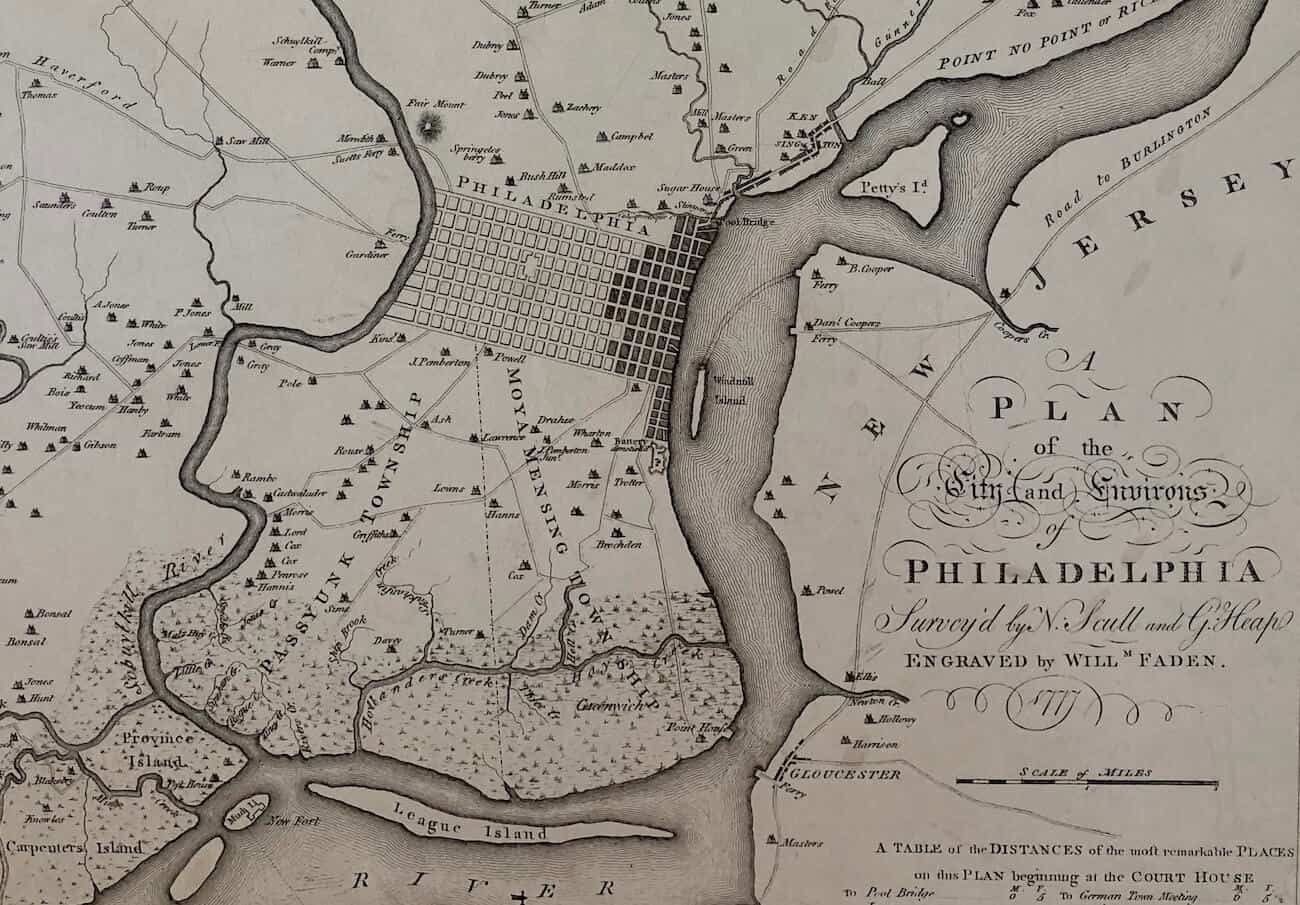
Philadelphia Guided Walk Map
This map gives an overview of the destinations on this walk. Detailed walking directions are included later in this post.
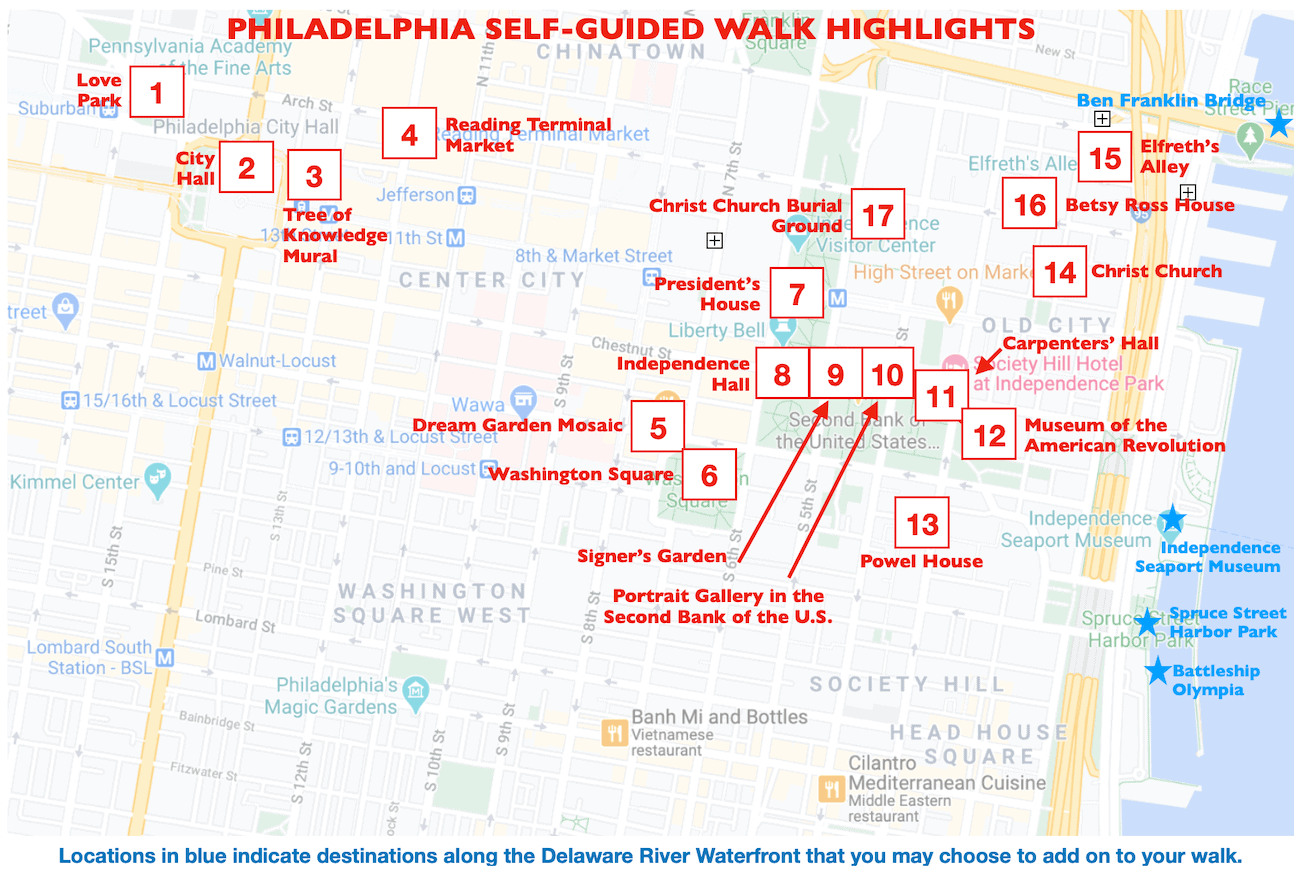
1. Love Park
Located just a short walk from City Hall, Love Park (also known as John F. Kennedy Plaza) features the highly recognizable Love statue created by Robert Indiana in 1976. 1599 John F. Kennedy Blvd.
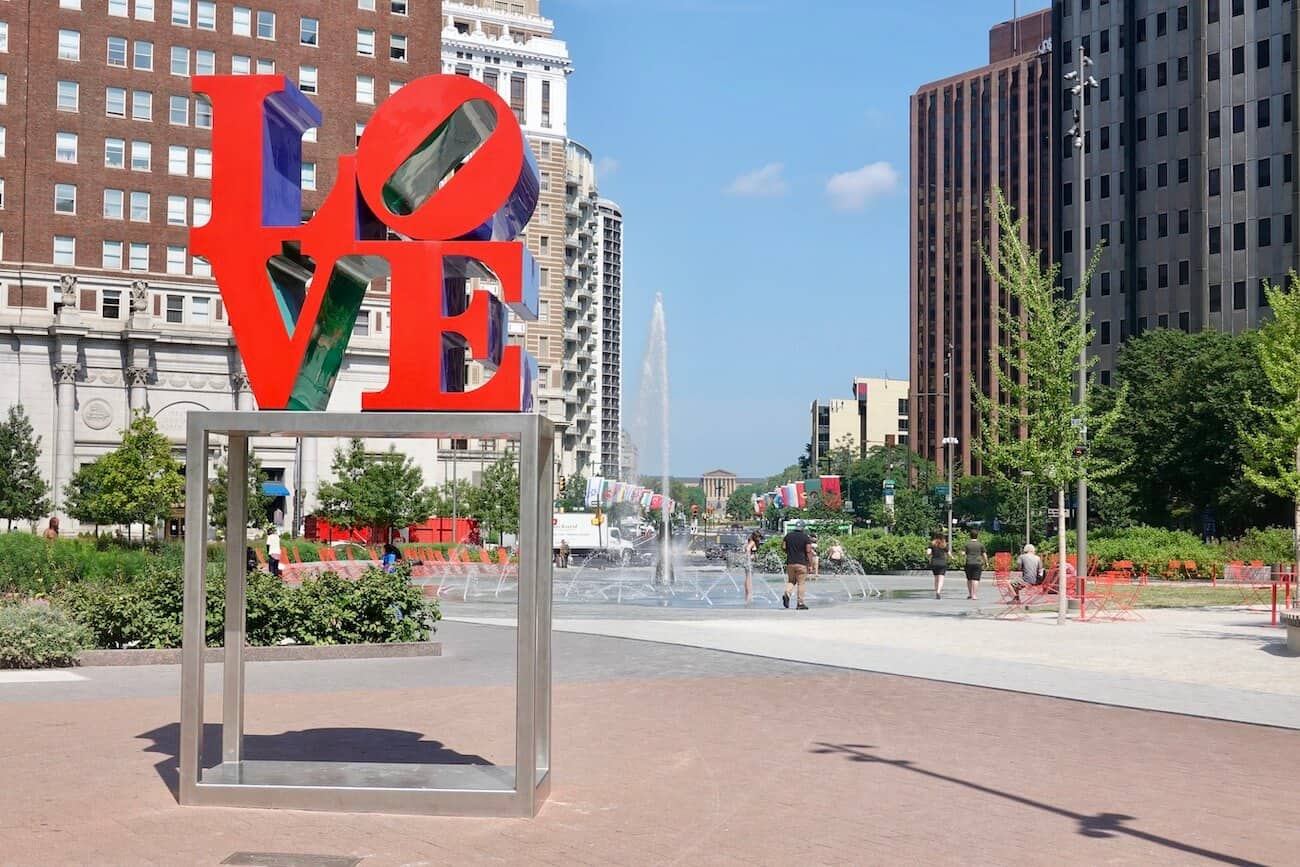
Museums Galore (save for another trip)
With City Hall behind you, look past the Love statue down Ben Franklin Parkway to the Philadelphia Museum of Art in the distance. If you continued down the parkway, you’d find The Academy of Natural Sciences and the Franklin Institute on your left; the Barnes Foundation and the Rodin Museum would be on your right.
2. City Hall
An iconic landmark, Philadelphia’s City Hall is crowned with a massive statue of William Penn, the founder of the colony and, later, the state.
If you cannot take a tour of the interior (usually available twice a day), it’s still worth a look at the impressive exterior architecture with sculptures of seasons and the seven continents (along with other figures). Although not the original city hall, this building is on the original site set aside for public buildings by William Penn in 1682. It took 30 years to build the present structure. 1 S. Penn Square.
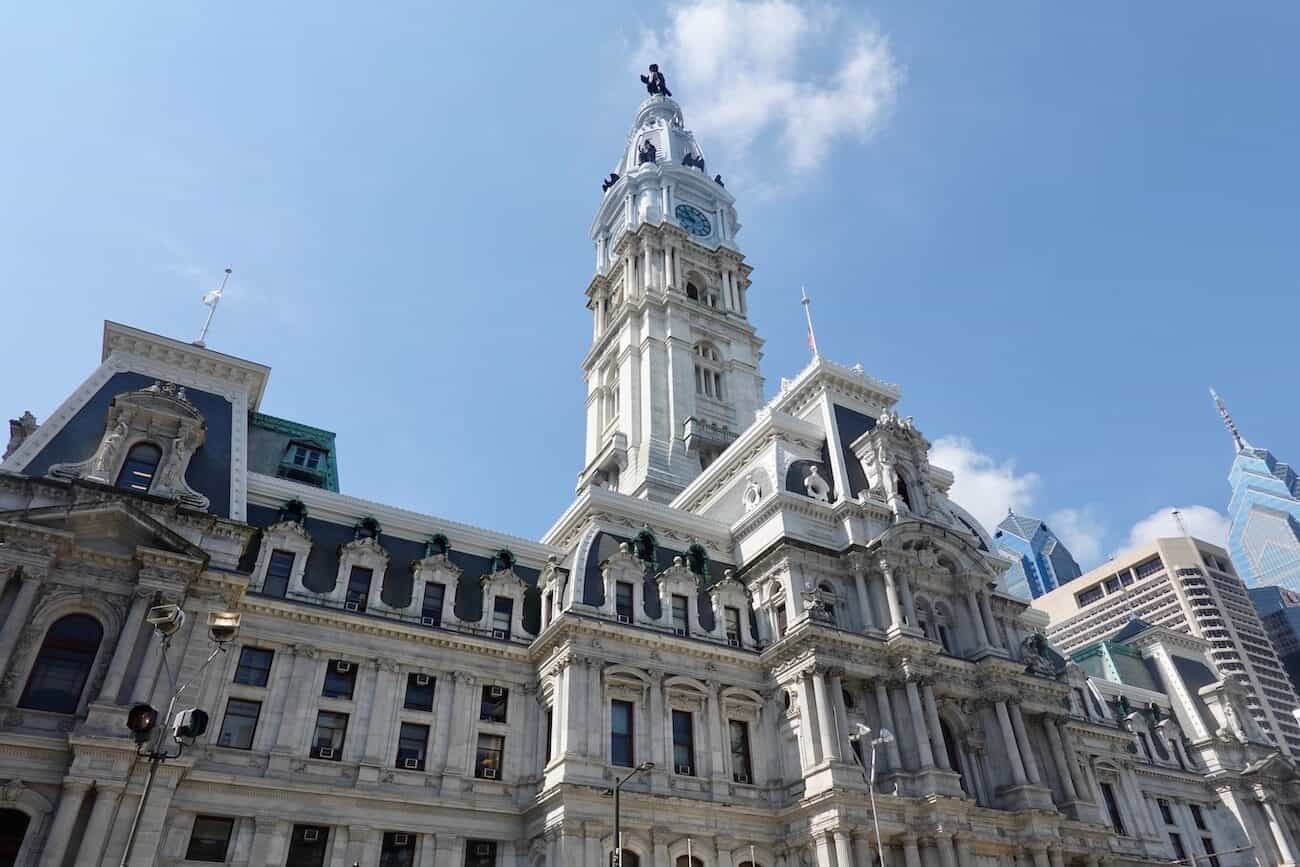
Head north on N. Juniper St/Penn Square toward Market St. Take a sharp right on Market St. (less than 5 minute walk)
3. The Tree of Knowledge Mural
The Tree of Knowledge mural shows a tree with objects embedded in its branches that depict, according to its artist Michael Webb, “objects alluding to the breadth of human endeavor, knowledge, and perseverance.” You’ll notice an abacus, a book, a horn, a key, a lamp, a ruler, a sextant, and more. Philadelphia is sometimes dubbed the City of Murals, so you’ll probably notice quite a few during your visit. 1301 Market Street
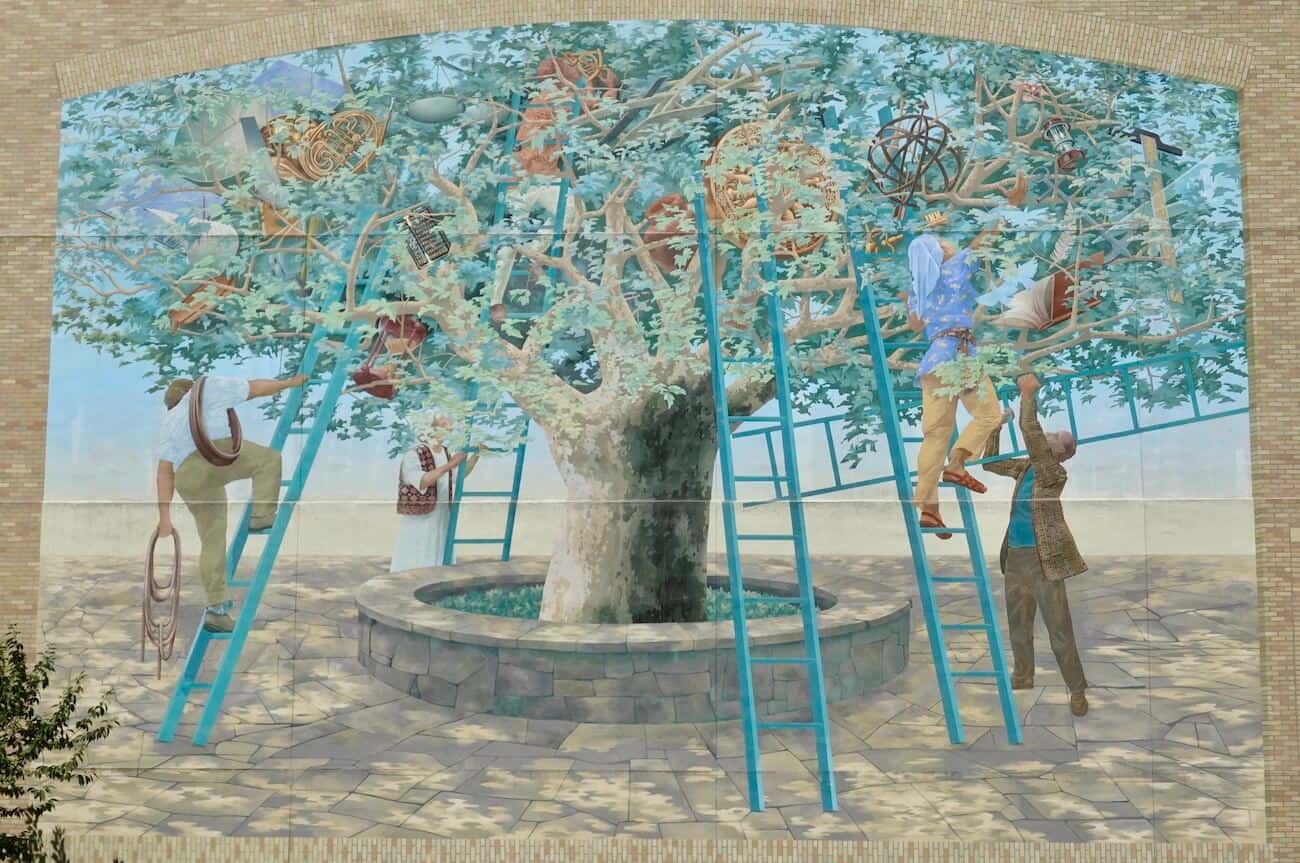
To continue the walk, head north on N. Juniper St/Penn Square. Turn right on Filbert St. Turn left on N. 12th St. Reading Terminal Market is on the right. (about a 5-minute walk)
4. Reading Terminal Market
Constructed in the late 1800s, the Reading Terminal Market hosts many food stalls (over 70 stalls) and dining options today. You can pick up a picnic lunch to enjoy on a stop along your walk or simply browse the alluring treats. 51 North 12th Street
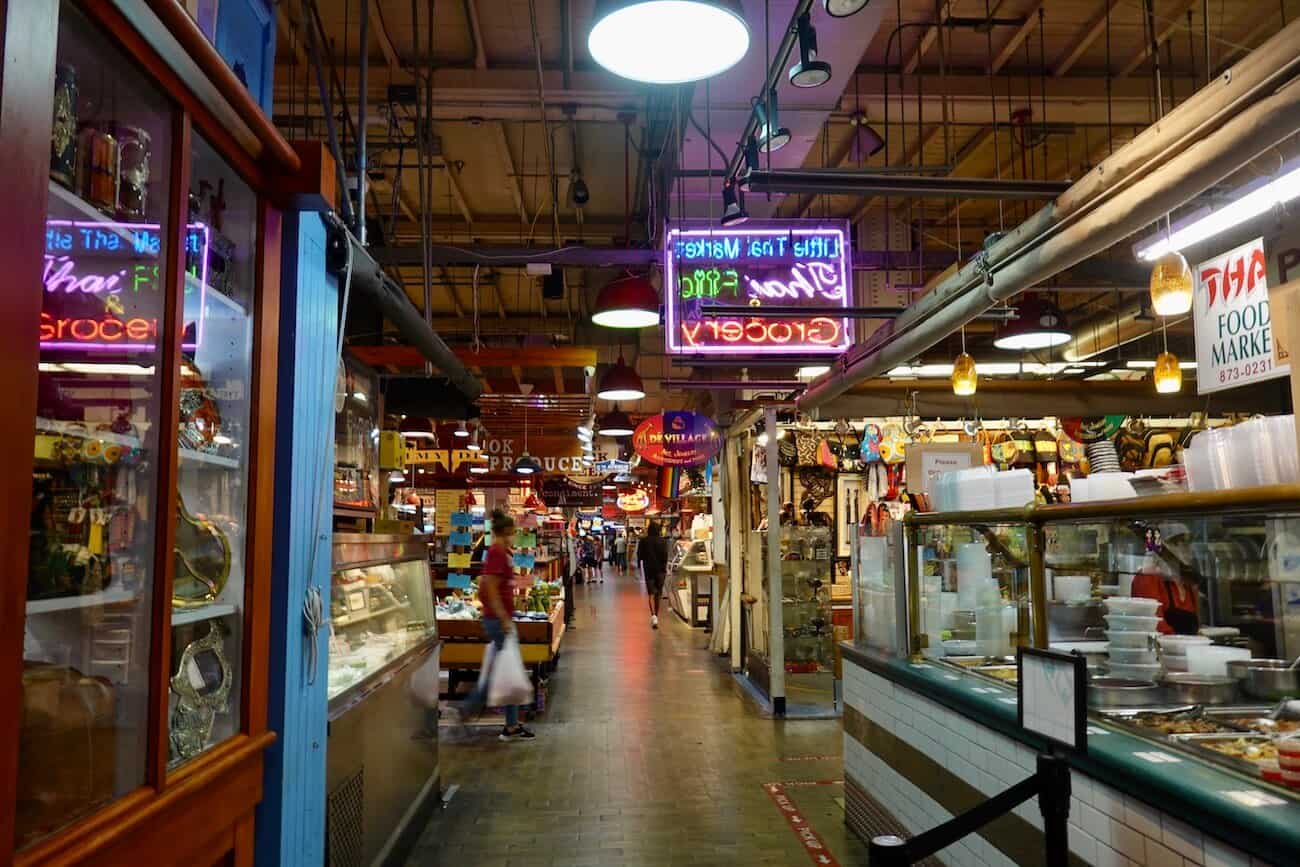
To continue the walk, head south on N. 12th St (for 0.3 miles); turn left on Walnut St.; continue for 0.5 miles. (about a 15-minute walk)
5. Dream Garden Mosaic
In the Curtis Center lobby is a beautiful, large Tiffany mosaic made of more than 100,000 pieces of glass in 260 colors. Its landscape scene was designed in 1916 by Maxfield Parrish and stretches almost 50 feet long.
The Dream Garden Mosaic is a fantastic piece of art that the Curtis publishing company commissioned in a quest to share art with the public. Enter the building on the 6th Street side to view the mural. No admission is charged. 601 Walnut Street
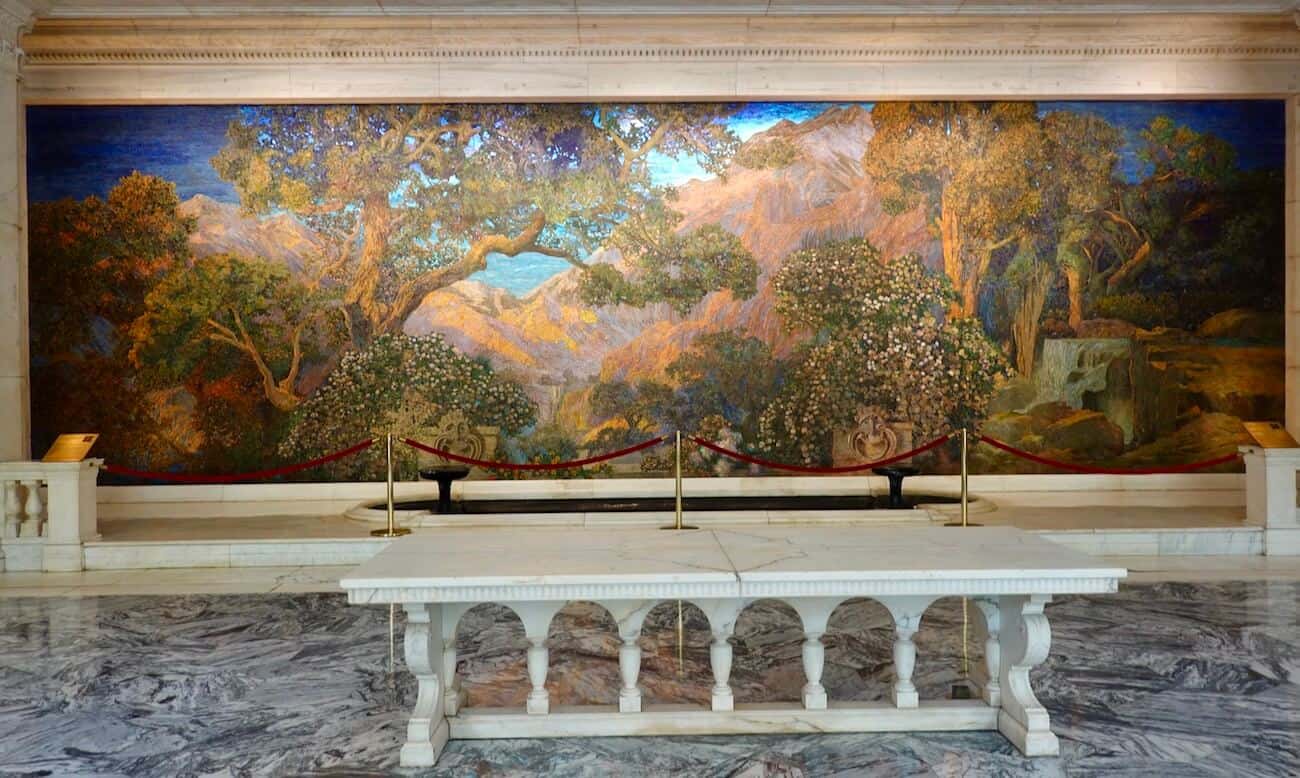
Back outside, proceed to Washington Square around the corner for a shady respite.
6. Washington Square
Shade trees and benches make this a perfect spot to relax and take a break from your wanderings. William Penn designed the city to have green oases for people to relax away from busy streets; today this one honors George Washington.
A statue of Washington looks over a tomb of the unknown soldier — with an eternal flame — to remember the countless American lives lost during the War of Independence. Incidentally, thousands of other souls are at rest underground in mass unmarked graves, including convicts, slaves, and epidemic victims. Informational displays in the square provide more historical details of this site.
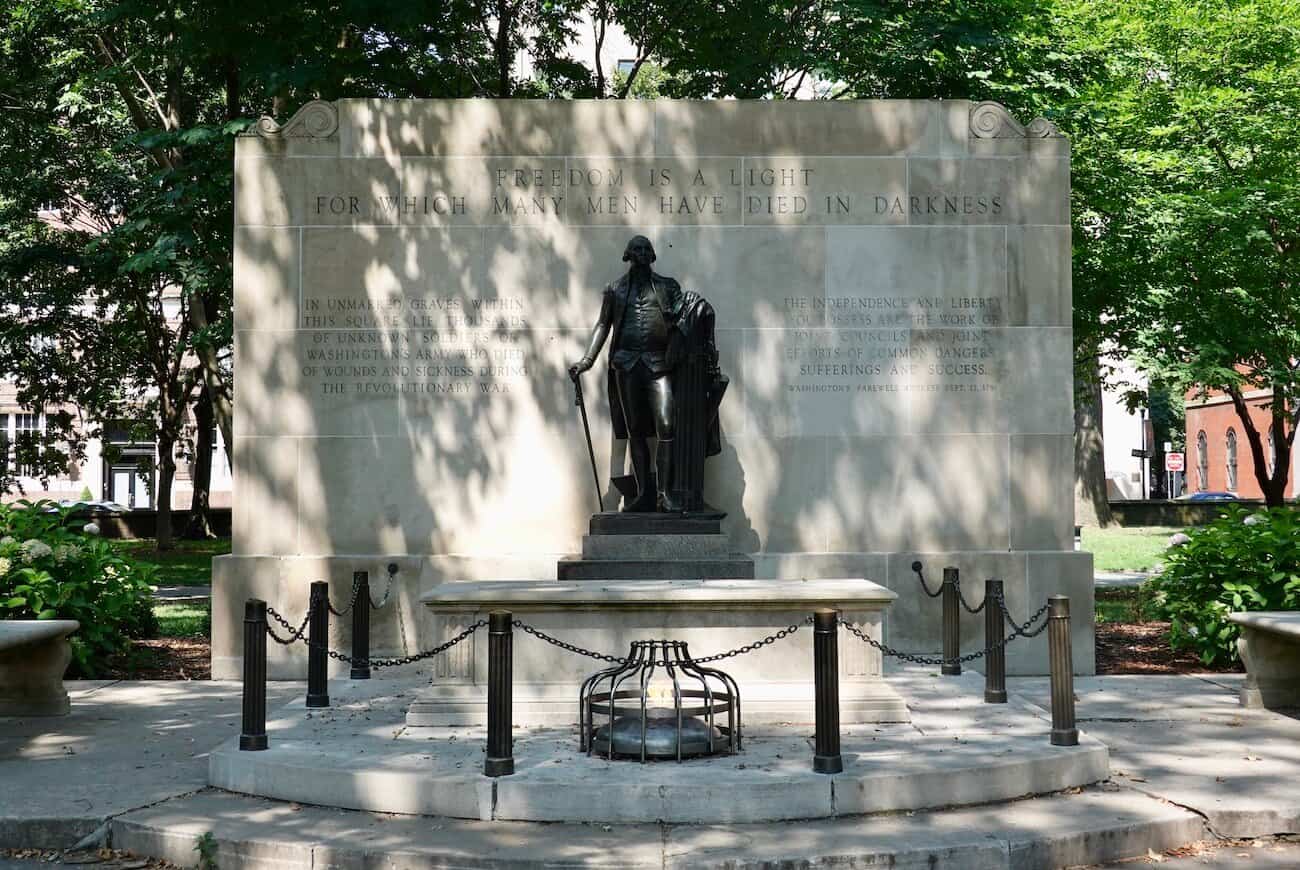
To continue the walk, head east on Walnut St. towards S. 6th St.; turn left on S. 6th St.; turn right on Market St. (about a 15-minute walk)
7. President’s House
Long before the White House became the executive mansion, this was the home of President George Washington and his successor, President John Adams. Today it’s an outdoor venue with the original foundation and walls outlined so visitors can imagine the structure as it once stood.
Information panels and videos at the President’s House allow you to learn more about the people who occupied this site — including the enslaved people who served the first two presidents. This is part of Independence National Historical Park. 6th and Market Streets
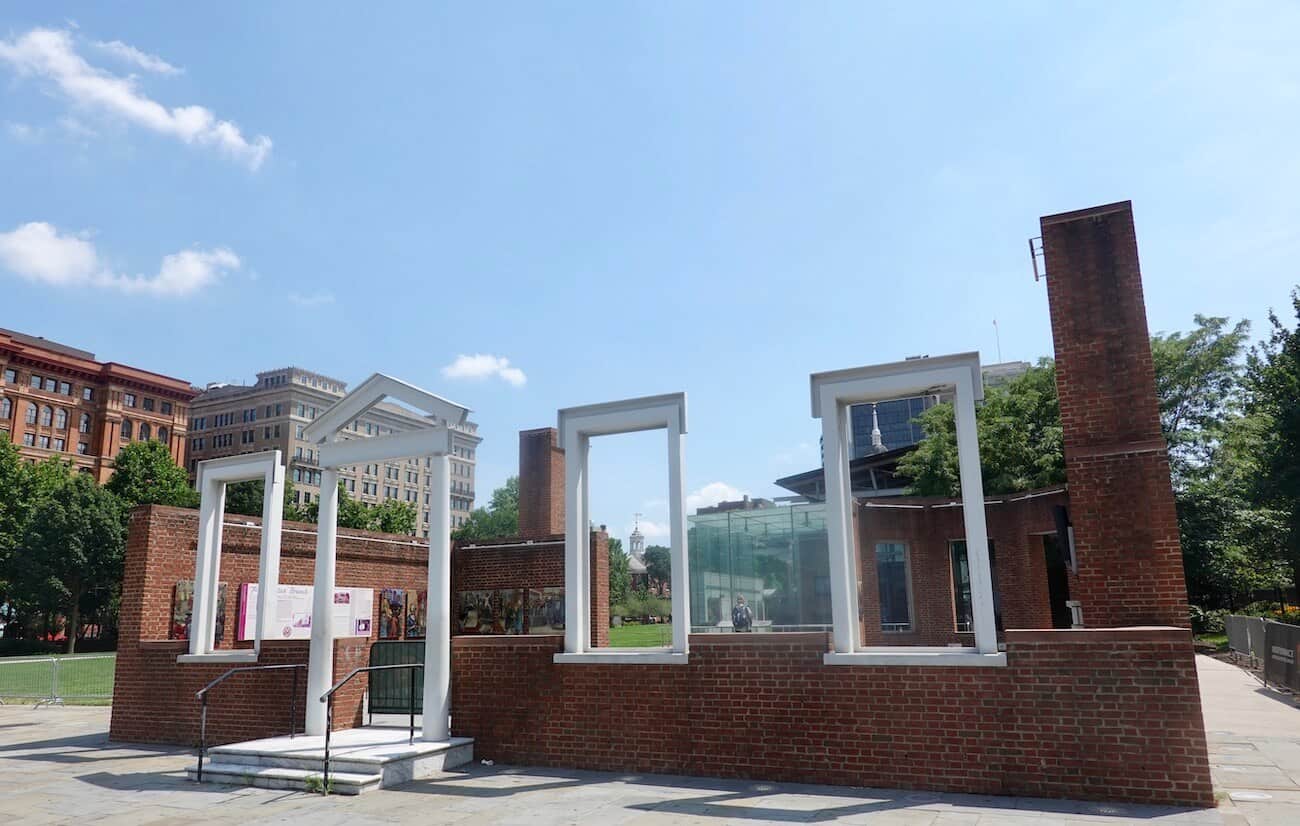
To continue the walk, head west on Market St.; turn left on 6th St.; turn left on Chestnut St. — or walk across the expansive lawn. (less than a 5-minute walk)
8. Independence Hall
One of the most popular sites in the Old City is Independence Hall. The two significant documents that defined the United States were debated and finalized in this building: the Declaration of Independence in 1776 and the U.S. Constitution in 1787.
Here you’ll learn about the building’s use as a city hall in colonial Philadelphia and how it became the meeting place for the country’s founding fathers. When you’re inside, you can almost picture the representatives from the colonies debating the issues while George Washington sat in the chair on the dais overseeing it all.
Adjacent to Independence Hall is Congress Hall where the U.S. Congress met from 1790-1800 and where George Washington and John Adams were both sworn in as presidents. Chestnut St, between 5th and 6th Streets; check online for tour hours
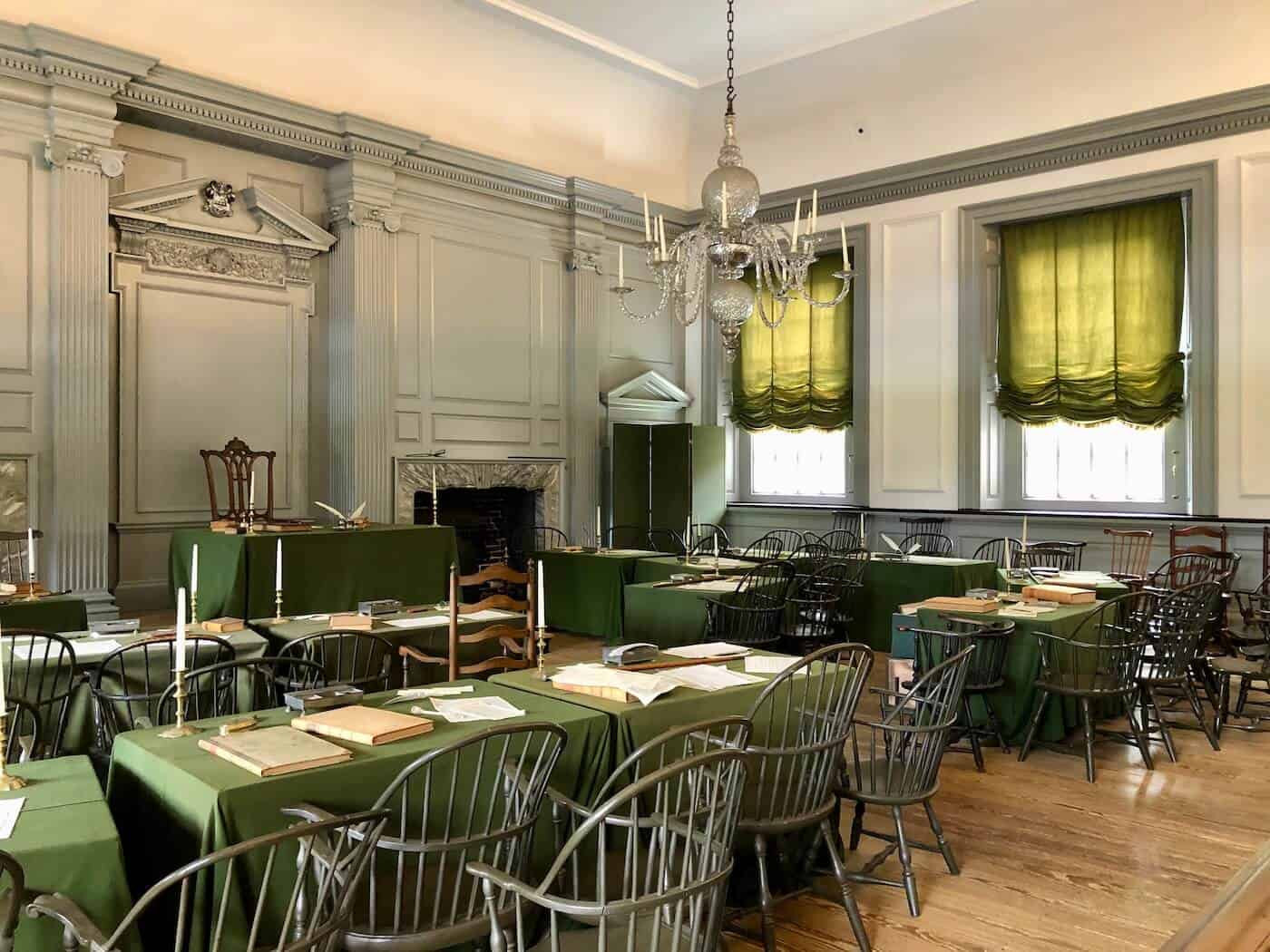
Independence Hall is one of many properties in Independence National Historical Park overseen by the National Park Service (NPS). It’s actually a huge L-shaped park that encompasses 55 acres and 20 city blocks. Download the NPS Independence app on your smartphone to help plan your visit and reference while walking through Independence National Historical Park.
Other attractions on these grounds include the Liberty Bell, the National Constitution Center, and the Independence National Park Visitor Center.
To continue the walk, head east on Chestnut St. toward S. 5th St. (1-minute walk)
9. Signer’s Garden
This statue, in a small garden across from Independence Hall, helps us remember the convictions of those who signed the Declaration of Independence and the Constitution of the United States. The nearby NPS plaque says it well: the statue “commemorates the courage of those who altered their lives, and ours, by affixing their names to these documents.”
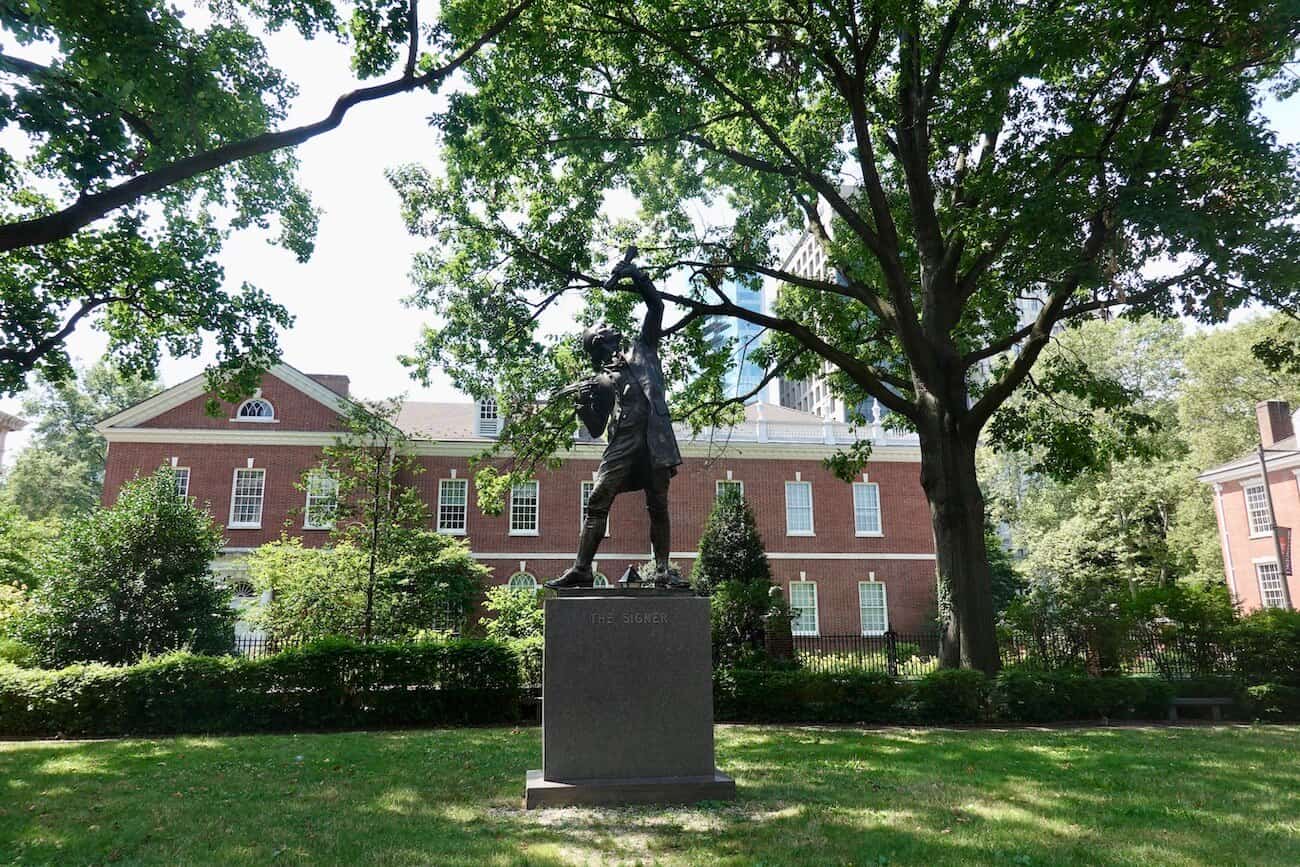
To continue the walk, head east on Chestnut St. (1-minute walk)
10. Portrait Gallery in the Second Bank of the U.S.
Stop in the Second Bank of the U.S. to see over 100 portraits of “worthy Personages” from the 18th century. Though most of the portraits were created by Charles Wilson Peale, there are also portraits by other artists featured here. The prominent “People of Independence” exhibit showcases those instrumental in helping create the United States as an independent entity from England.
The portraits become an interesting history lesson as you move from one to another. Each portrait comes with a short synopsis of the notable contributions that person made to what became the United States of America. Those contributions cover political, philosophical, scientific endeavors, and more.
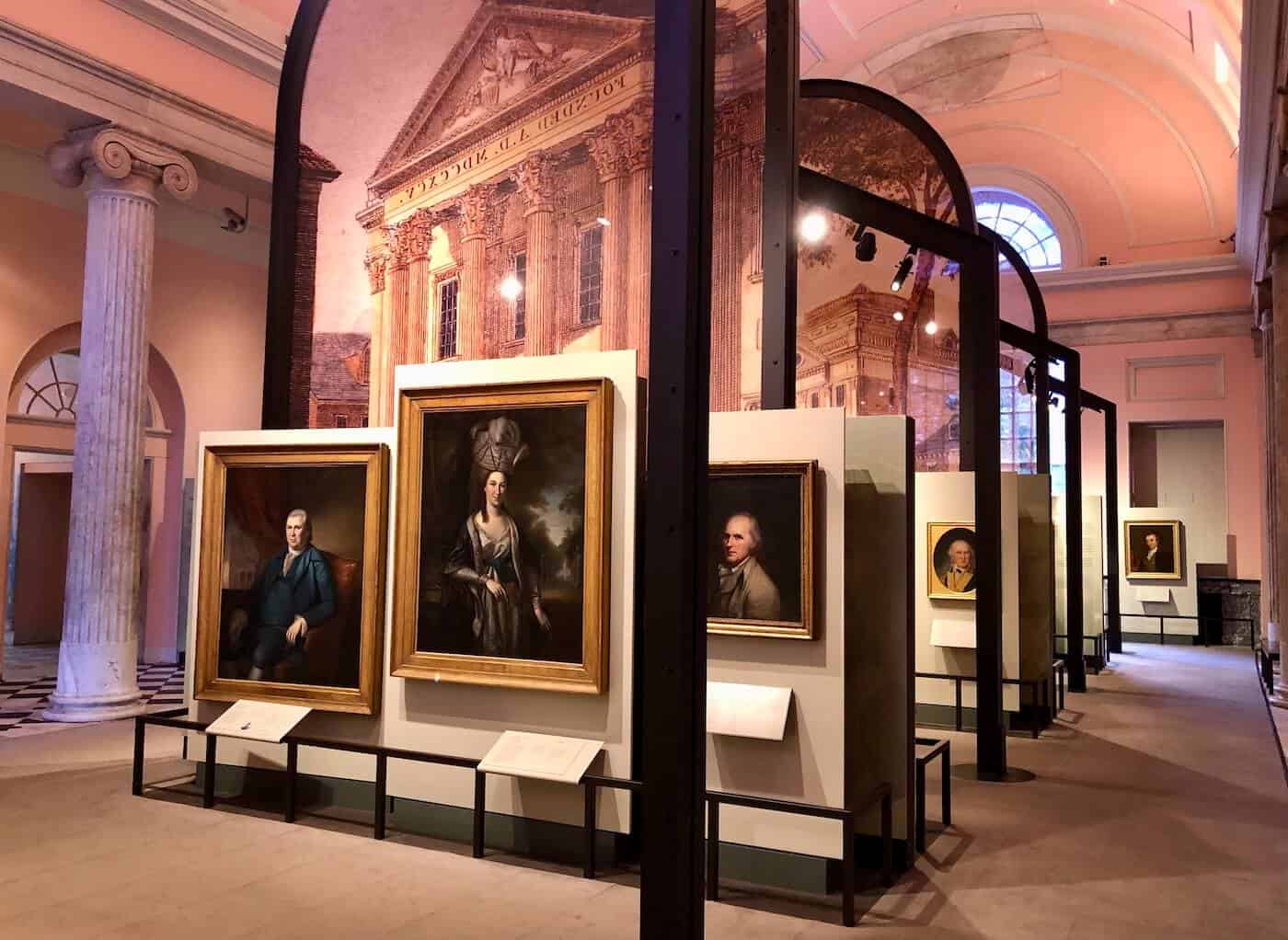
Also, if you’re familiar with some well-known places in Philadelphia, you’ll likely see the link to history while visiting the gallery. For example, Rittenhouse Square is named after David Rittenhouse (whose portrait is prominently displayed here), who was a friend of the American Revolution as well as a clockmaker and renowned astronomer.
By some portraits sits a wooden contraption called a physiognotrace. Ask a nearby NPS ranger for a demonstration, and you’ll learn how this was used to create a person’s profile for a silhouette, a popular form of portraiture at the time. Even more interesting is the story that comes with this one. Moses Williams, Peale’s slave, was taught to work the physiognotrace and became quite adept at it. As time passed, he earned his freedom and continued creating silhouettes for customers in a shop set up in Peale’s Museum.
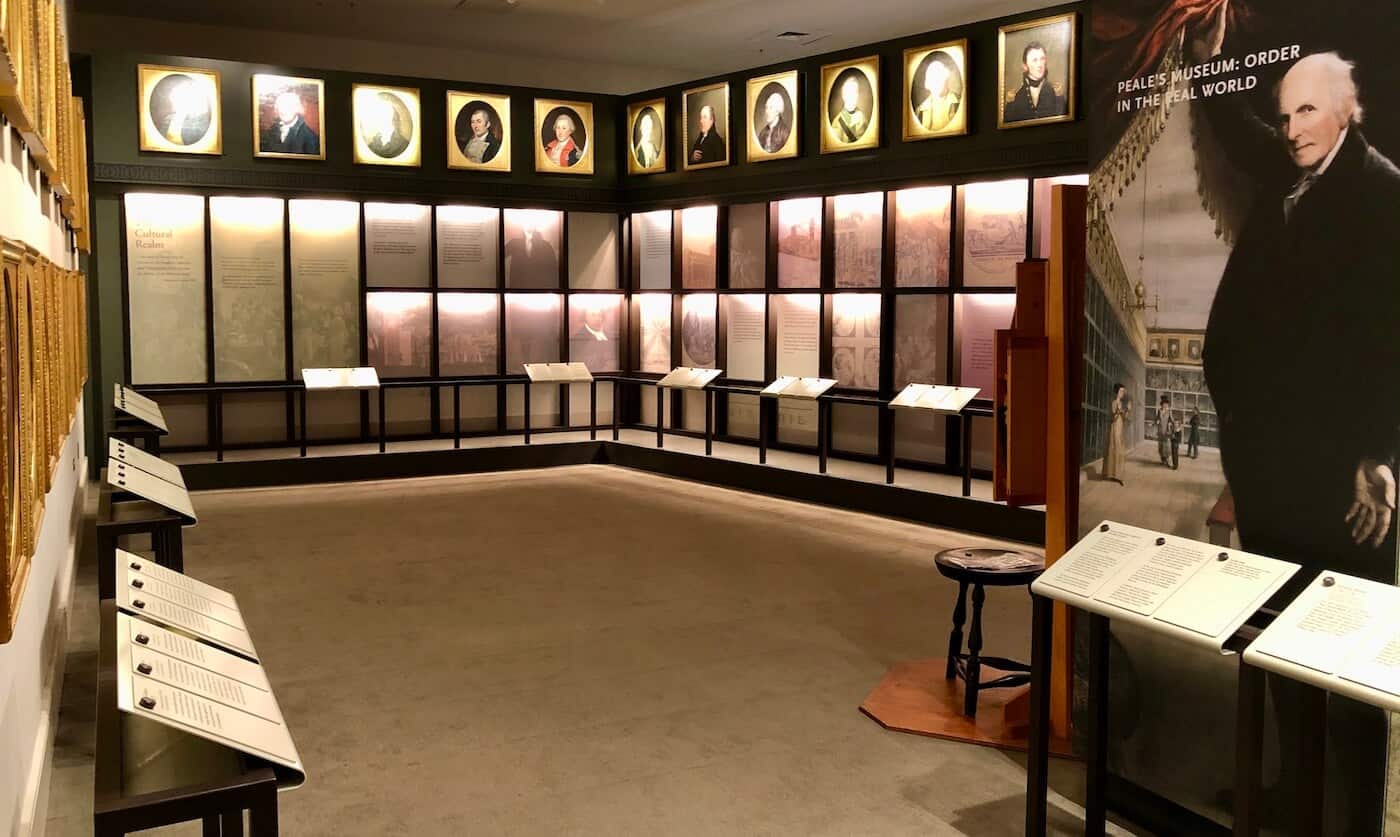
Don’t let the building’s imposing facade deter you from entering. Just walk up the steps, and you’ll be welcomed into the portrait gallery by National Park Service staff. Most likely, you will not encounter crowds of people here, so you can take your time inside. 420 Chestnut Street; free; open daily 10-5
To continue the walk, head east on Chestnut St.; turn right and continue down the cobblestone path to Carpenters’ Hall. The building is facing but set back from the street. (about a 2-minute walk)
11. Carpenters’ Hall
Initially, Carpenters’ Hall was constructed and used by the master builders and skilled craftsmen who made up the Carpenters’ Company, an association of master builders. It is the oldest craft guild in the country.
Since its creation in 1771, Carpenters’ Hall has been shared with various organizations, including Benjamin Franklin’s Library Company, Benjamin Franklin’s American Philosophical Society, and the First Bank of the United States. It was also an infirmary for disabled American soldiers at one point.
Most importantly for American history, Carpenters’ Hall was the First Continental Congress meeting place in 1774. Delegates from 12 colonies (Georgia did not send a representative) voted to begin a trade embargo with England. This sent a clear message to King George III that the colonists would not tolerate being taxed to help the Crown pay for expenses it incurred in America.
Interestingly, this was the first time that many of the delegates (including John Adams, Ben Franklin, Patrick Henry, and Thomas Jefferson) met each other as each of the colonies, up until now, had really conducted their business independently of one another.
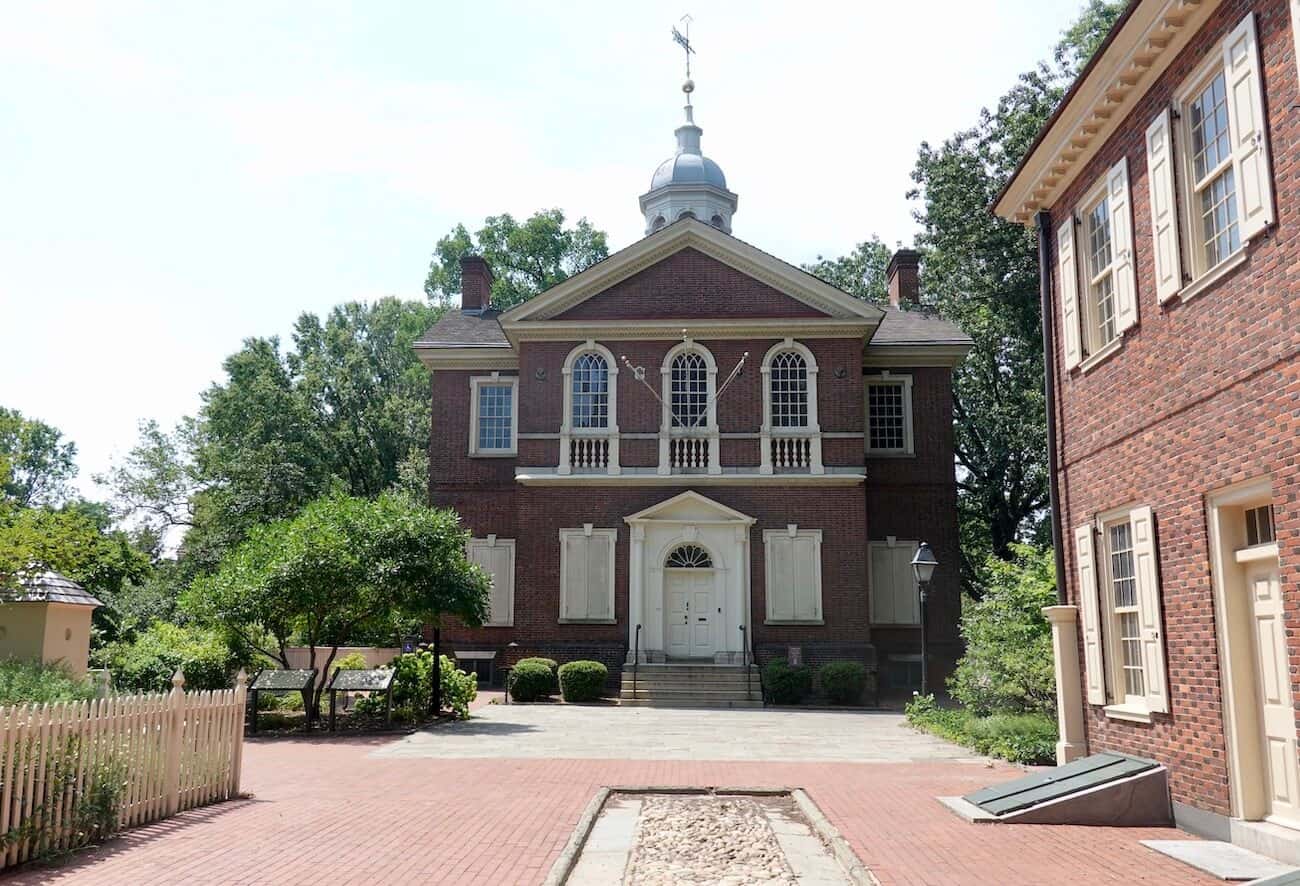
The general disgust with the king’s policies brought these leaders together to act as one unit. It was here that Patrick Henry stated that by meeting, they were no longer just men representing their colonies; instead, they were all Americans. This meeting set the stage for what was to come: the writing of the Declaration of Independence and, later, the American Revolution as well as the creation of the U.S. Constitution.
Before visiting, check out the detailed history of this C-SPAN video. Also, there is a walking tour of nearby Old City and Society Hill sites associated with Carpenters’ Company members. Today this building is part of Independence National Historical Park.
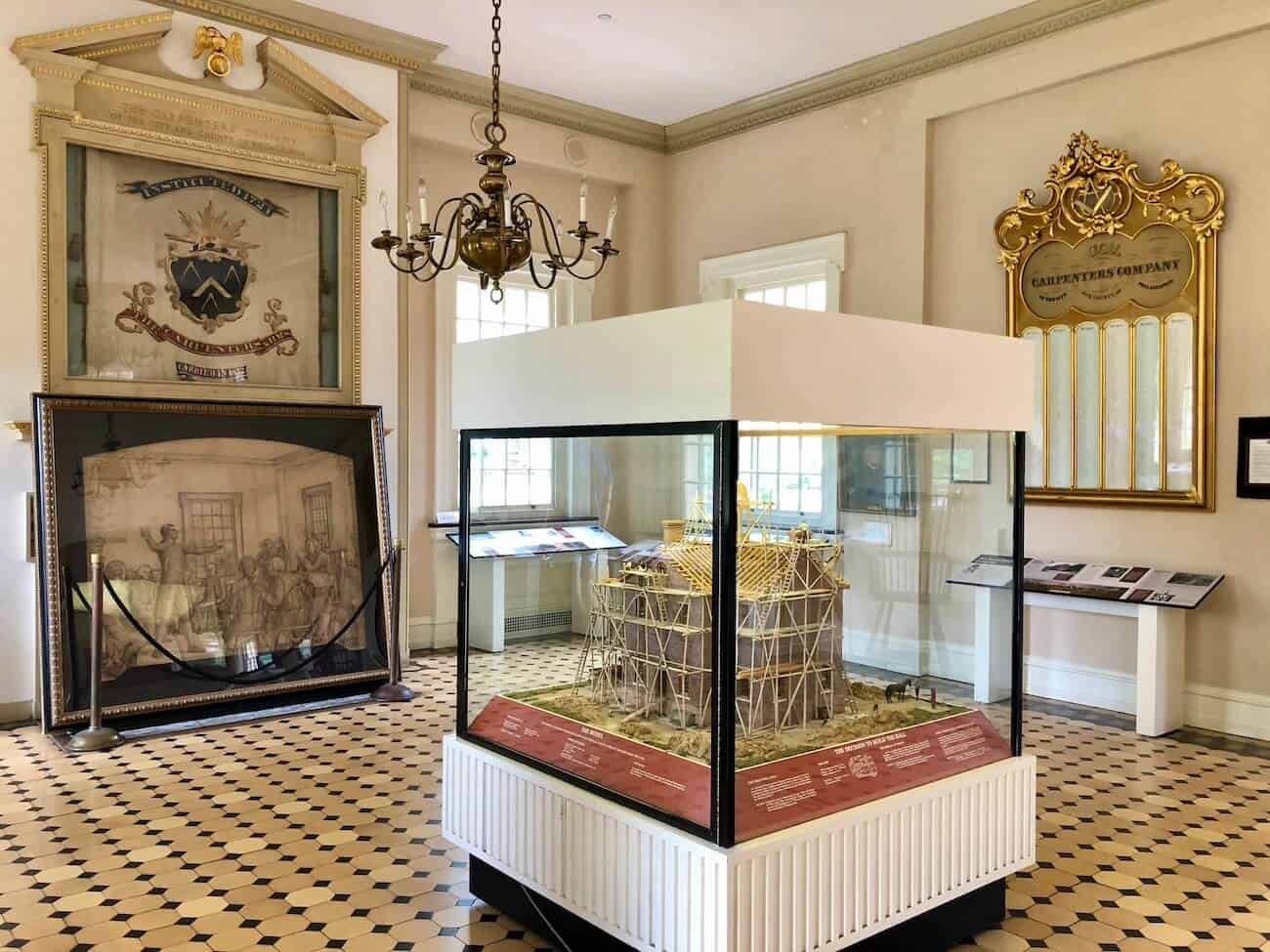
The building represents so much rich history, but your visit may just include the first floor; still, there are displays and related descriptive signs that help you imagine what life was like for our forefathers who gathered here. No admission is charged. 320 Chestnut Street; free; open Tues-Sun 10-4 most weeks
To continue the walk, head east on Chestnut St.; turn left on S. 3rd St. (about a 2-minute walk)
12. Museum of the American Revolution
Philadelphia has many fine museums, but this fairly new one — originally opened in 2017 — is dedicated to the War of Independence. The Museum of the American Revolution boasts impressive exhibits and dioramas that explain the causes, the battles, and the lingering effects of the American Revolution still evident today. An excellent museum. This is on the grounds of Independence National Historical Park. Use my museum guide to plan your visit. Admission charged. 101 South 3rd Street
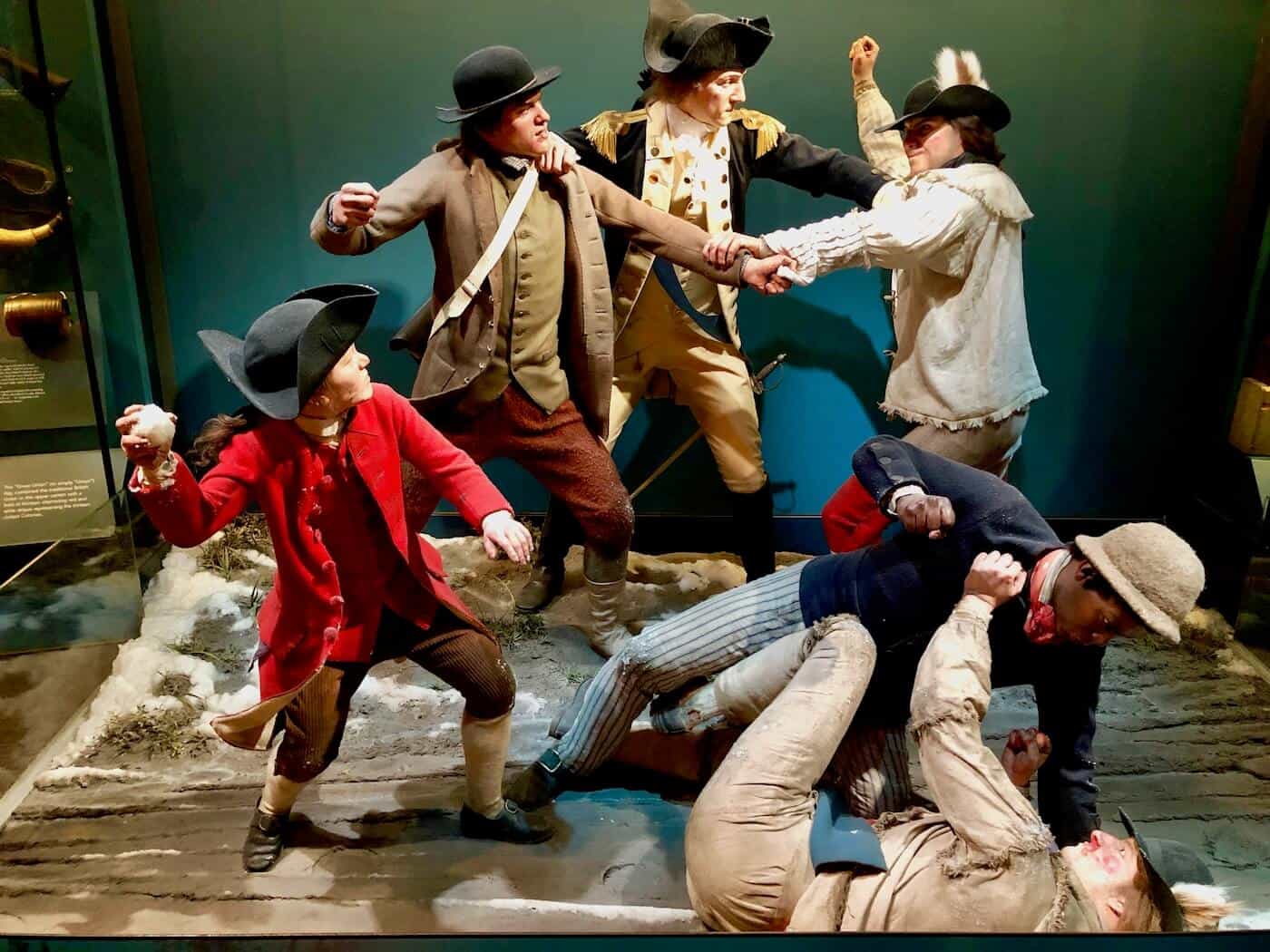
To continue the walk, head south on 3rd St. (less than a 5-minute walk)
13. Powel House
Samuel Powel, a wealthy Philadelphian, was the last mayor of this colonial city and the first mayor after the American Revolution. He and his wife, Elizabeth, were prominent socialites and hosted George and Martha Washington numerous times in their home. During the American Revolution, British soldiers occupied the home. After Ben Franklin died in 1790, Powel was a pallbearer at his funeral. Check online for information on tours of the Powel House. Admission charged. 244 South 3rd Street
To continue the walk, head north on 3rd St.; turn right on Church St. (about a 10-minute walk)
14. Christ Church
Dubbed “America’s Church,” this was a place where several American legends (including Ben Franklin, Betsy Ross, and George Washington) once worshipped. Founded in 1695, this was the colony’s first Church of England parish. Inside is a 14th-century baptismal font from the British church where William Penn was baptized. The church is in use today, and if you’re not visiting during services, you can livestream them from home. 20 N. American Street
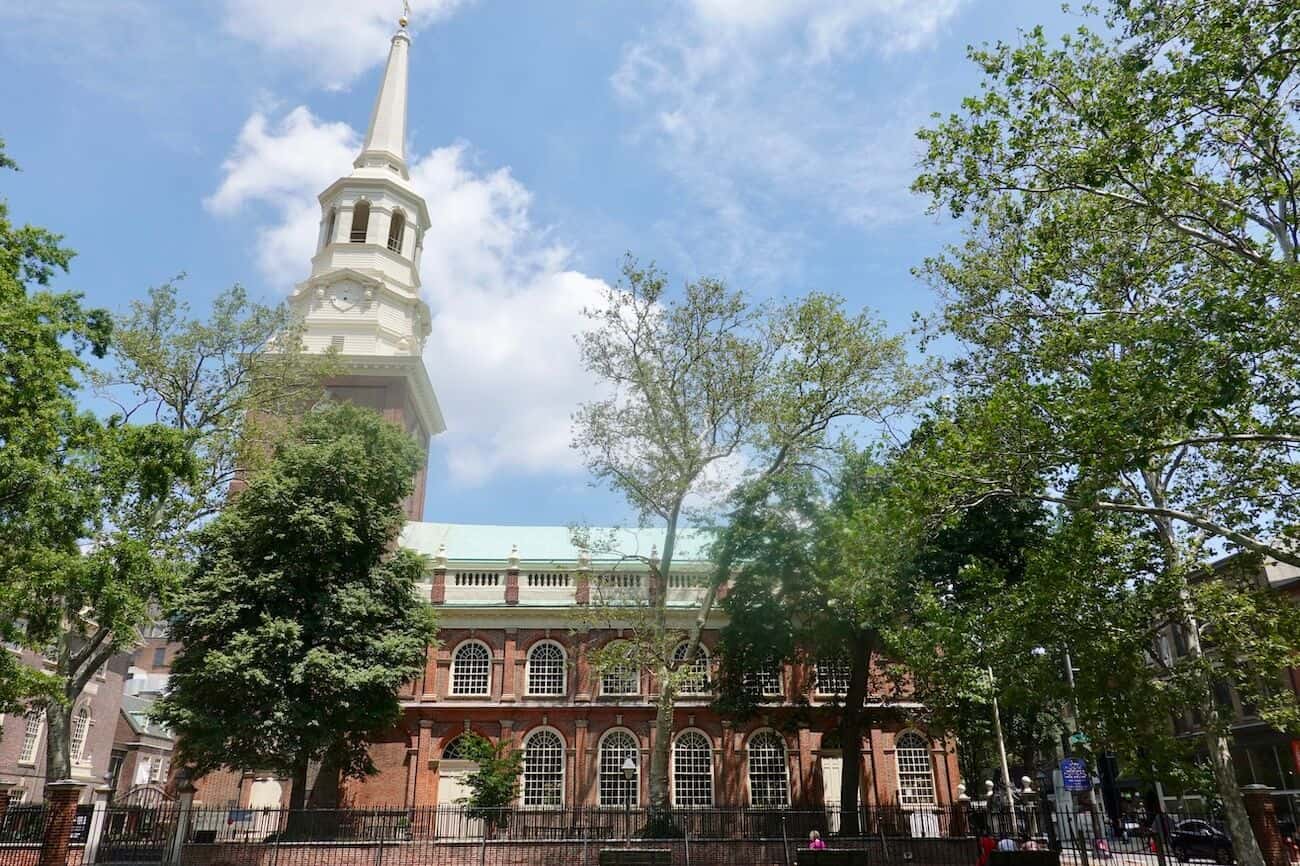
NOTE: You will visit the Christ Church Burial Ground in a few more stops, a few blocks away. First, though, is the next closest destination on this tour: Elfreth’s Alley. Head north on N. 2nd St.; turn right onto Elfreth’s Alley. (about a 5-minute walk)
15. Elfreth’s Alley
This charming, picturesque lane is the oldest residential street in the U.S. and dates back to 1720. The alley was originally a cart path between properties that allowed access from 2nd Street down to Front Street by the Delaware River. Philadelphia was a busy port city at the time — a hub of commerce in the colonies.
The alley is named after Jeremiah Elfreth, a local land developer and blacksmith. Most of the well-tended row homes are still occupied today; there is a small museum in buildings #124 and #126.
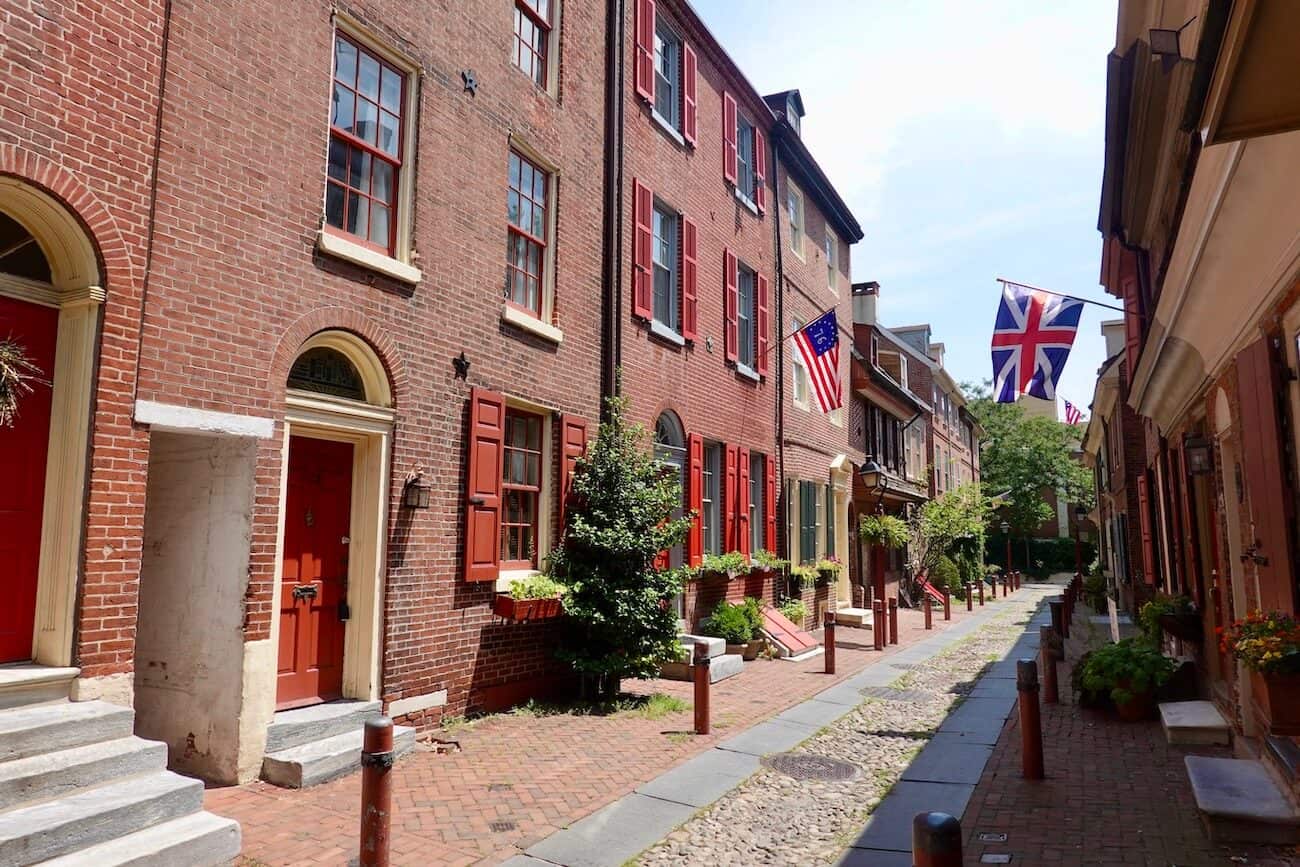
To continue the walk, head west on Elfreth’s Alley; turn left on N. 2nd St.; turn right onto Arch St. (about a 5-minute walk)
16. Betsy Ross House
Many tourists visit the Betsy Ross House to learn more about America’s first flag and enjoy discussing the process of creating the flag with “Betsy” herself, a costumed docent. There is some doubt that this is actually the house she lived in — it may be the one next door — but it’s an enjoyable visit nonetheless. Admission charged. 239 Arch Street
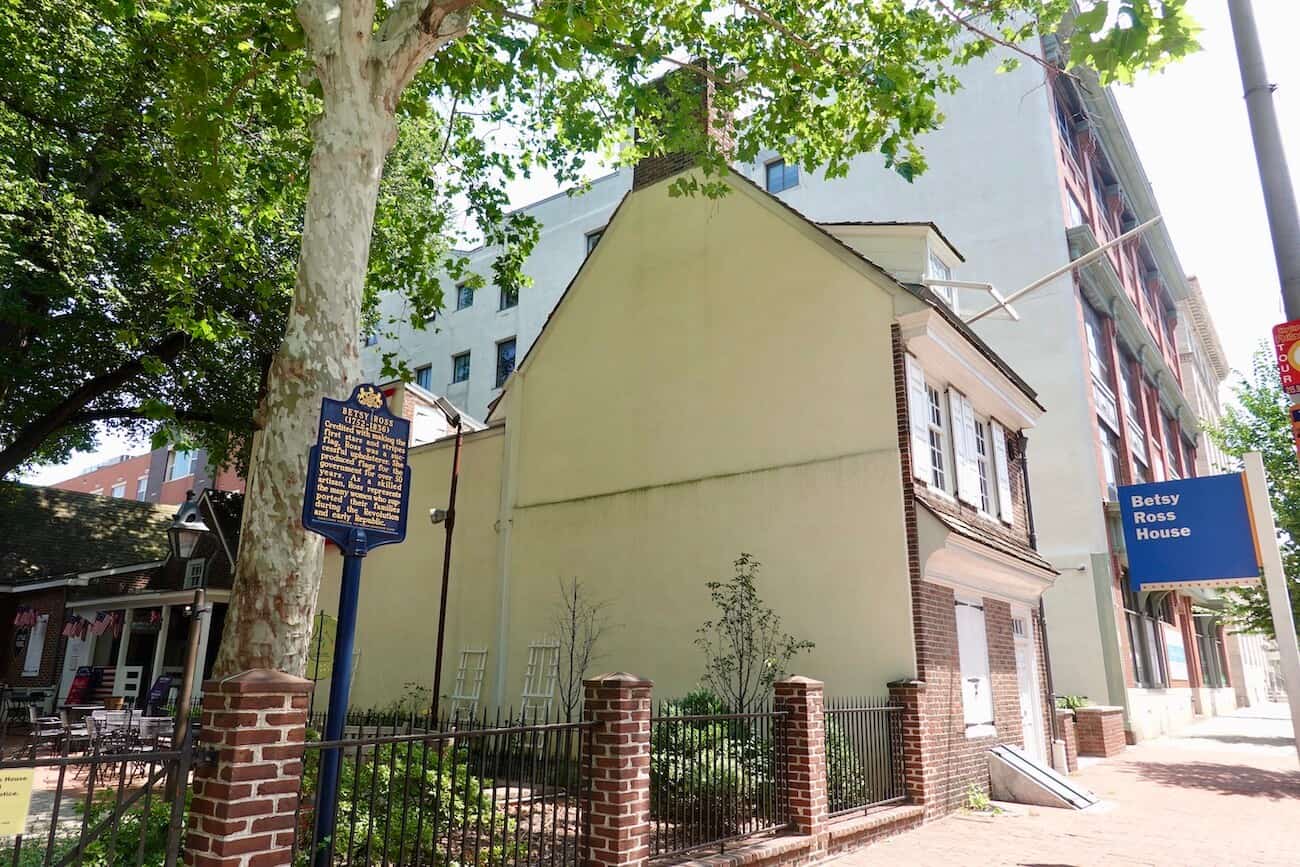
Now onto the Christ Church Burial Grounds! Head west on Arch St. (about a 5-minute walk)
17. Christ Church Burial Ground
Christ Church Burial Ground is the final resting place for 1,400 souls, including five signers of the Declaration of Independence (Benjamin Franklin, Joseph Hewes, Francis Hopkinson, George Ross, and Benjamin Rush). This is on the grounds of Independence National Historical Park. Limited hours; admission charged. 5th & Arch Streets
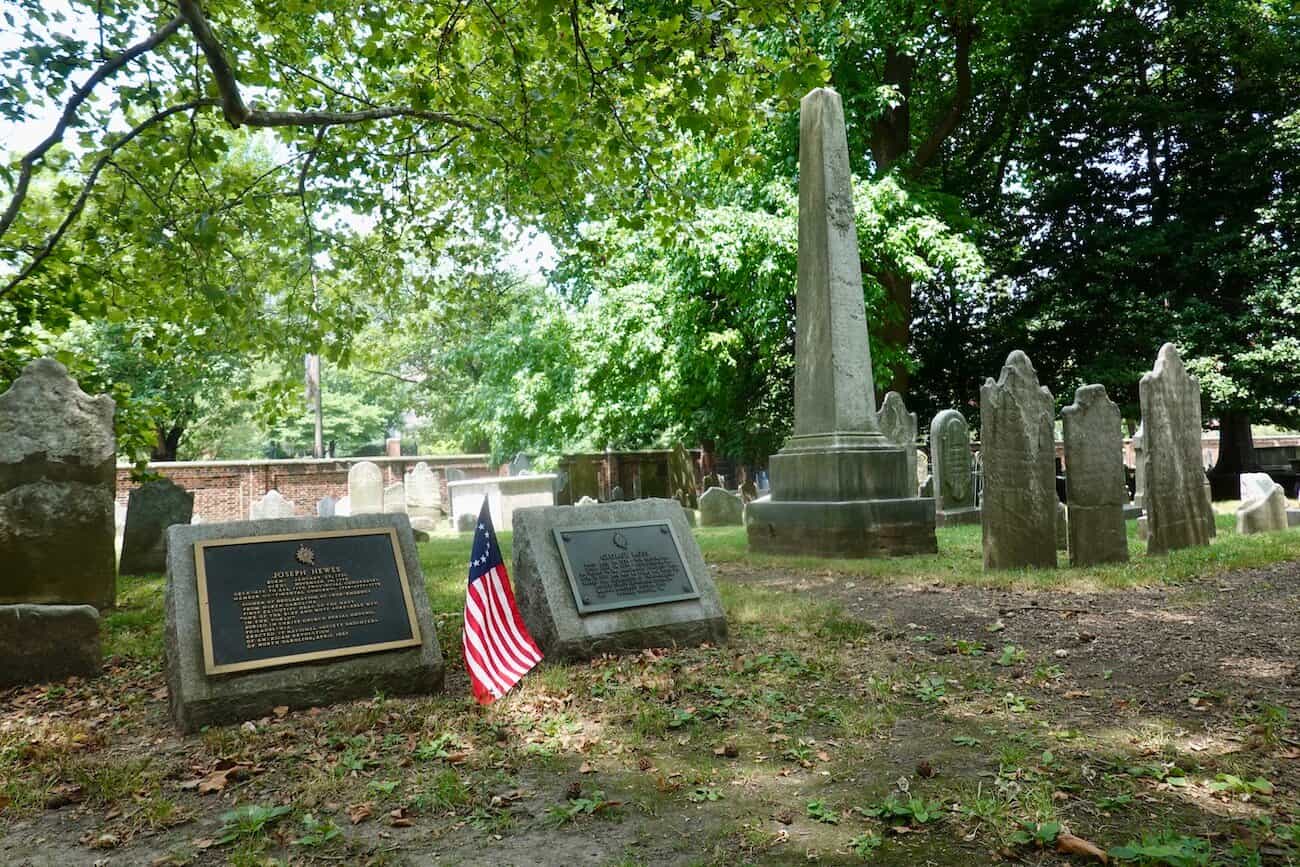
To return to City Hall on foot, head west on Arch St. for 0.8 miles; turn left on N. Juniper St.; turn right onto Filbert St.; turn left on N. Juniper St. (about a 20-minute walk)
WATERFRONT DETOUR: If you’re interested in some time on the waterfront, consider visiting the Delaware River Waterfront.
Penn’s Landing
This reclaimed area along the Delaware River waterfront is popular for recreation, festivals, and concerts. Here you’ll find the Independence Seaport Museum, and the battleship Olympia along with places to relax and dine. N. Columbus Blvd on the Delaware River
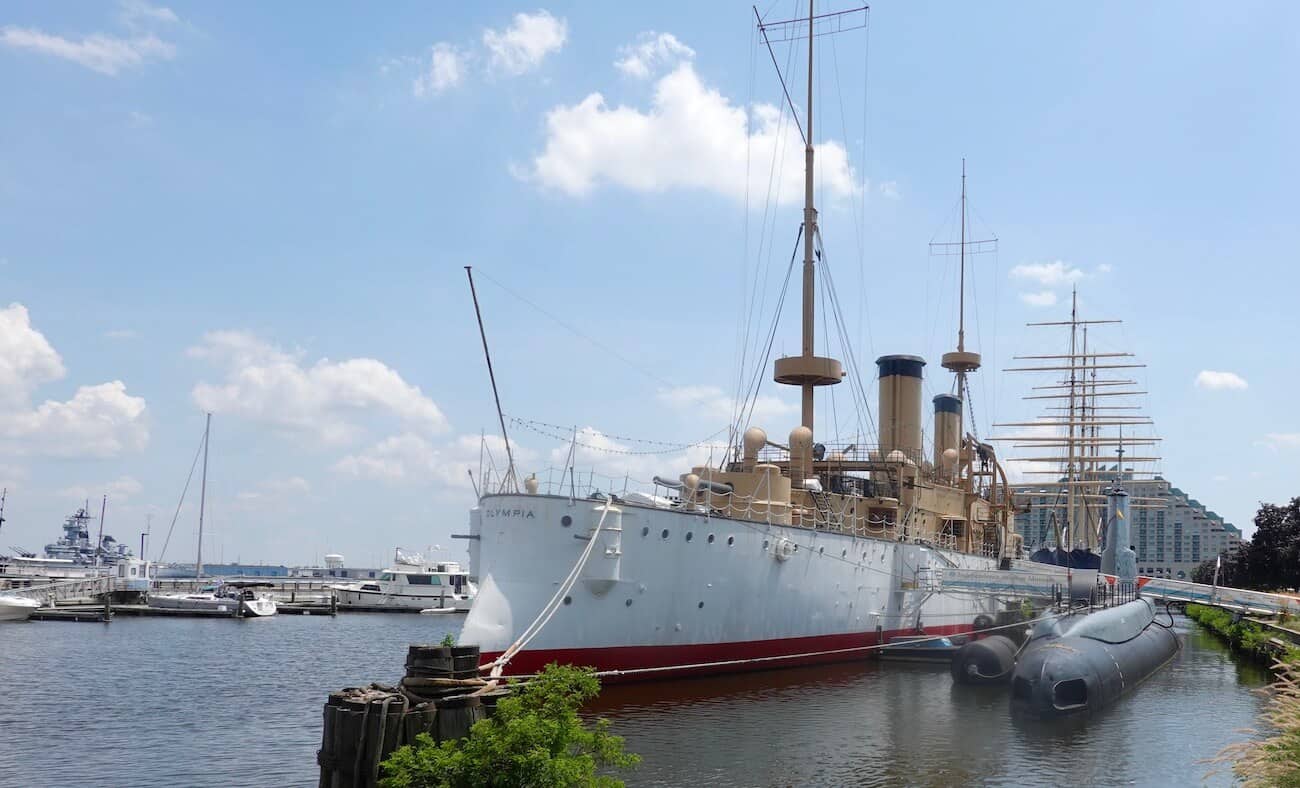
Spruce Street Harbor Park is a seasonal venue offering relaxing spots while enjoying craft beer, wine, and food. You can also walk onto the Ben Franklin Bridge for a view of the city; enter at the pedestrian entrance on 5th Street.
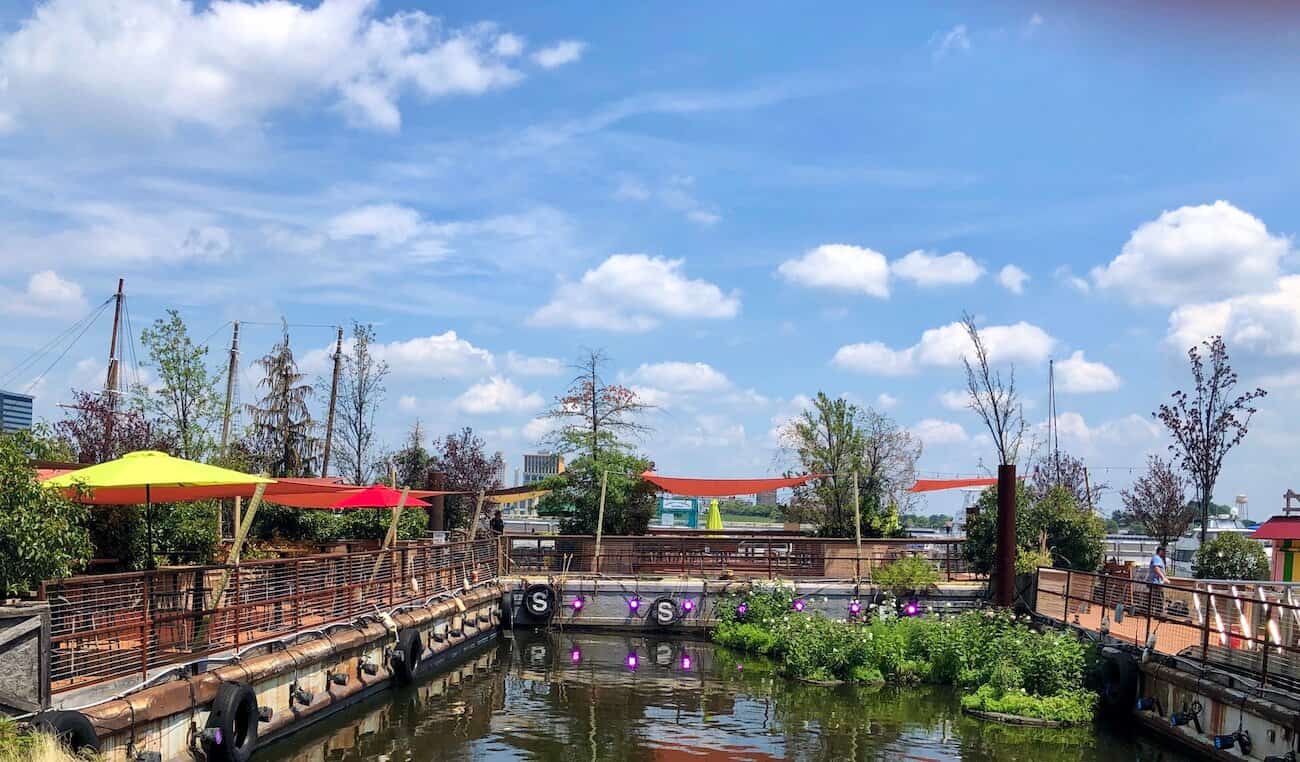
How to Plan Your Walk
Begin your walk anywhere along the route. Choose what you want to see and the order of sites on your list.
1. Check Online First
Check online for the historical buildings and museums you want to visit. Then you’ll get an idea of the days and hours of operation. Also, some venues may suggest timed tickets that you must order beforehand.
2. Watch Videos Beforehand
Several of the destinations have videos to watch on their websites. View them before your visit; you will probably appreciate this walk much more. In addition, for a bit more detailed historical background information, there are excellent resources on Khan Academy, such as this video that explains the issues that the founding fathers grappled with: The Constitutional Convention.
3. Use Apps as Helpers
Navigation Apps – Most of us use our favorite navigation apps when driving, but they are also beneficial when walking. Consider Apple Maps and Google Maps for walking directions. I sometimes preload the places I want to walk and go from stop to stop. However, many navigation apps have a fixed limit on the number of stops you can add, so I’d suggest combining some (like those adjacent to each other) so you don’t go past the limit.
SpotHero – This is a handy app to find parking options. Enter your destination, when you plan to use the lot/garage, and SpotHero will provide choices with the associated costs. (I don’t use the option to reserve a spot, but I use the app to find parking options.)
TripAdvisor/Yelp – Decide to grab a bite, but don’t know of any good nearby restaurants? TripAdvisor or Yelp will help you find a nearby restaurant for lunch or even another site to visit. Reviews will help guide your decision-making process.
For more electronic helpers, check out my full list of the best travel apps and websites.
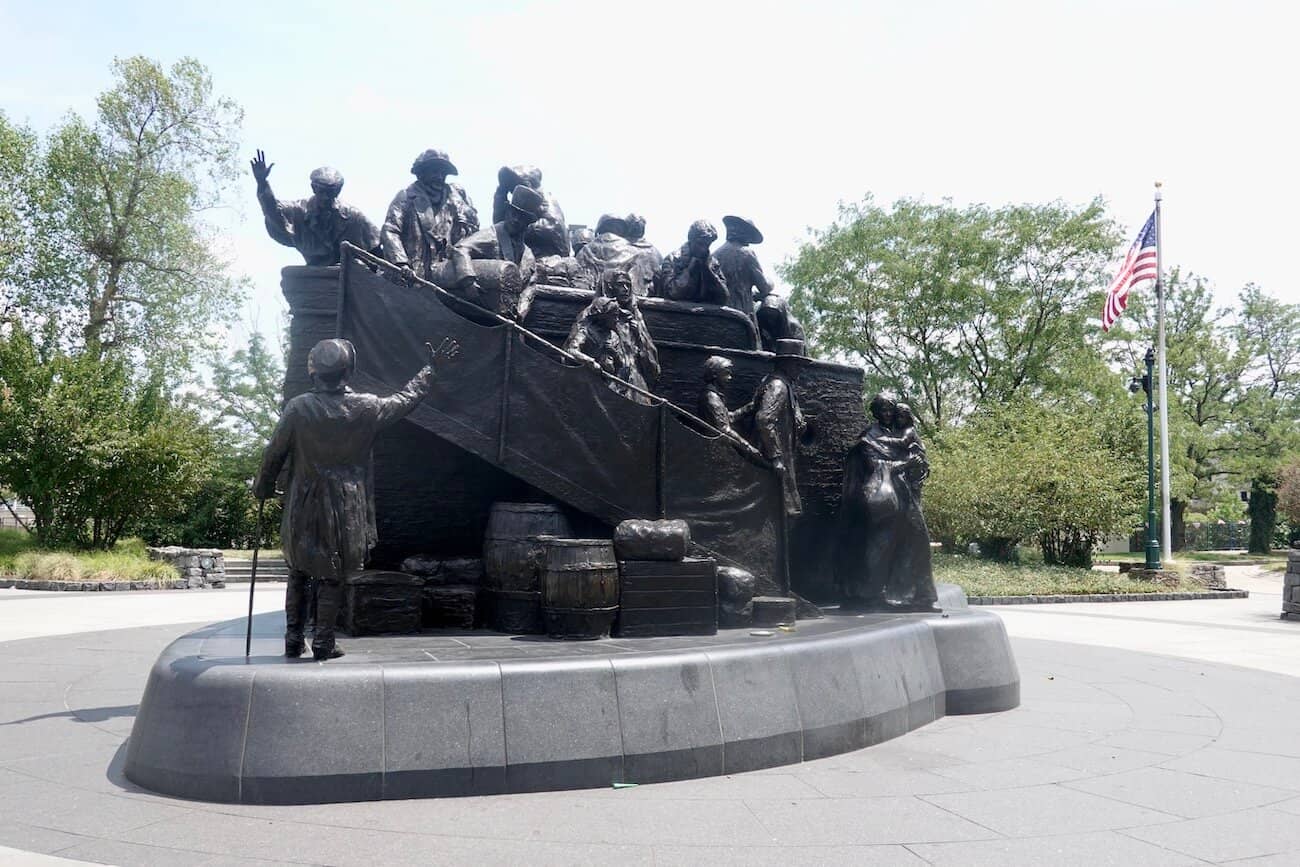
Philadelphia’s Historic Highlights
- Philadelphia became the capital of the colony of Pennsylvania by William Penn in 1682 and was the largest city of the colonies.
- Representatives sent from the colonies met in 1774 at the First Continental Congress (in Carpenters’ Hall) to organize their resistance to English rule. During those sessions, delegates began to change the prevailing mindset of thinking as separate colonies to thinking as a united body of Americans.
- The colonial delegates met in Independence Hall in 1775 at the Second Continental Congress to organize a governmental body to prepare for what became the American Revolution.
- Thomas Jefferson wrote the Declaration of Independence, later signed by representatives of the colonies in 1776.
- Philadelphia saw several significant battles nearby during the American Revolution.
- British soldiers took control of Philadelphia in 1777-1778, ousting patriots who opposed the king.
- After the American Revolution, the founding fathers met at the Constitutional Congress in 1787 to discuss — and later come to a consensus — the structure of the new American government.
- General George Washington was elected the first president of the United States of America in 1789 and was sworn in at Congress Hall, adjacent to Independence Hall.
- George Washington and John Adams lived in Philadelphia during their respective presidential terms. Today, the President’s House (near Independence Hall) shows the original placement of the home’s walls and provides informational displays.
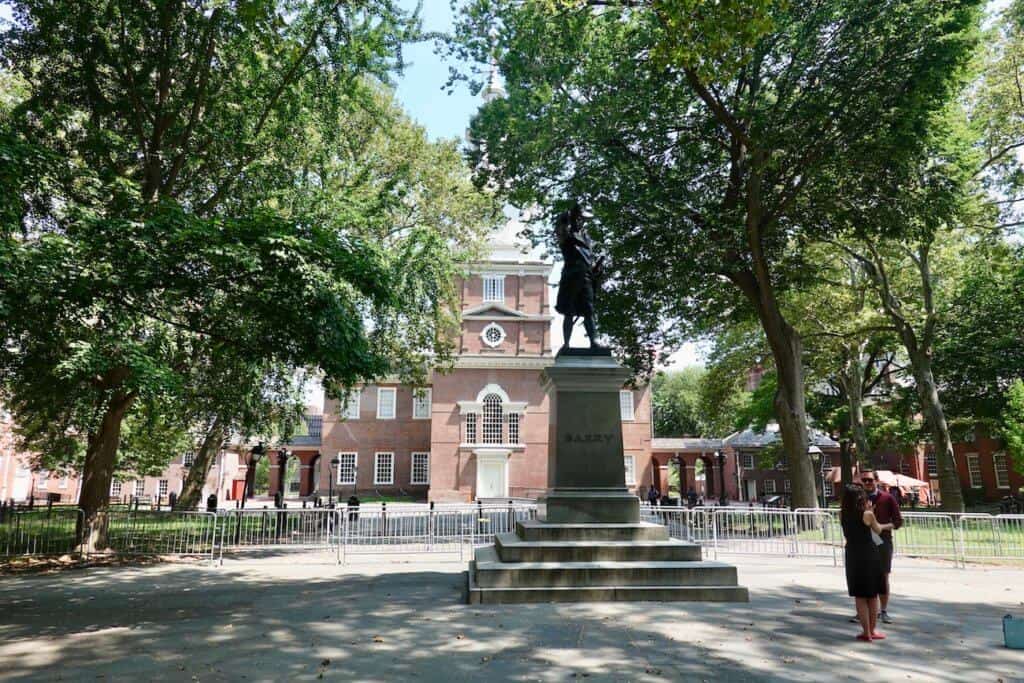
Philadelphia’s Public Art
In addition to the history made here in the 18th century. Philadelphia is widely known as “The City of Murals.” Graffiti was a major issue years ago, and some properties became eyesores. In the 1980s, murals were viewed as an excellent way to beautify public spaces; they also helped to support local artists.
Since the program began, thousands of murals have been painted around the city. Check out the Mural Mile map that highlights significant works of public art to find ones you want to include on your walk.
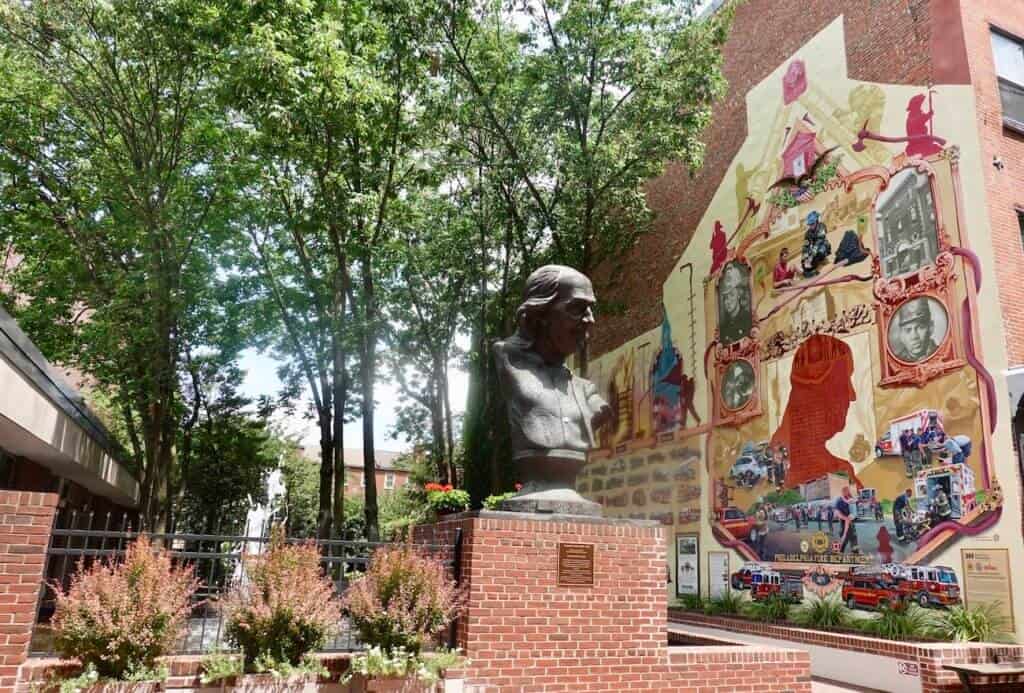
Nearby Attractions
Besides this self-guided walk, there are other fun things to do in the city. For another interesting place to visit just outside Philadelphia, consider Washington Crossing Historical Park, where George Washington’s troops camped several weeks before he led them across the Delaware River on Christmas Day, 1776.
If venturing to the other side of the state, check out the best of Pittsburgh and southwestern Pennsylvania. There you’ll find historic sites, forts, and museums documenting its place in history (notably the French and Indian War in the mid-1700s); two unique homes designed by Frank Lloyd Wright; and seemingly endless miles of hiking and biking trails along with some picturesque waterfalls (at Ohiopyle State Park).
Other great locations to explore in Pennsylvania are:
- Big Pocono State Park, Poconos
- Bushkill Falls, Poconos
- Colonial PA Plantation, outside Philadelphia
- Covered Bridge Driving Tour of Bucks County
- Covered Bridge Driving Tour of the Lehigh Valley
- Gettysburg Visitor Guide
- Hawk Mountain Sanctuary, Lehigh Valley area
- Hickory Run State Park, Poconos
- Housenick Park, Lehigh Valley
- Jacobsburg State Park, Pocono area
- John Heinz National Wildlife Refuge, outside Philadelphia
- Museum of the American Revolution, Philadelphia
- National Museum of Industrial History, Lehigh Valley
- Best Things to Do in Philadelphia
- Philadelphia: Fairmount Park’s Unique Colonial Mansions & Their Stories
- Pittsburgh and Southwestern Pennsylvania Guide
- Promised Land State Park, Poconos
- Ricketts Glen State Park, Poconos
- Ridley Creek State Park, outside Philadelphia
- Tyler State Park, Bucks County
- Valley Forge National Historical Park, outside Philadelphia
- Washington Crossing National Historical Park, in PA, outside Philadelphia
Final Thoughts
Walking through Philadelphia’s historic Old City – and stopping to view some statues and murals, visit some historical buildings, and take breaks in shady tree-lined parks – is a relaxing way to spend a few hours. Add visits to some historical buildings and museums, and you’ll quickly fill up a whole day or two. (But it’s so worth the time!)
While walking, you will undoubtedly ponder the amazing feats of our founding fathers, who navigated our country from a colonial power to an independent nation whose democracy has been a model around the world. Furthermore, you can enjoy the artistic treats for our eyes in the many sculptures and murals that adorn the Old City area of town. Overall, this walk is a nice blend of old and new.
Finally, remember to wear comfortable walking shoes, bring water, and sunscreen on sunny days.
Comments?
Please share your experiences and/or suggestions for other places to visit in Philadelphia and the surrounding area. Your ideas could be helpful to other travelers. Thanks! 🙂

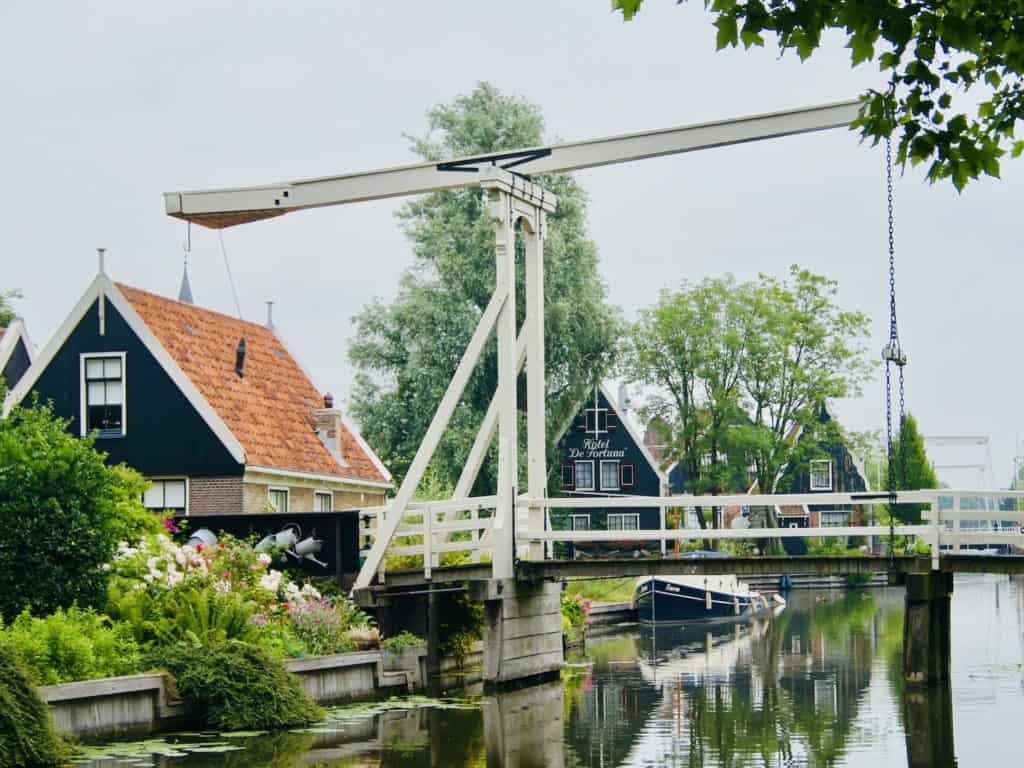
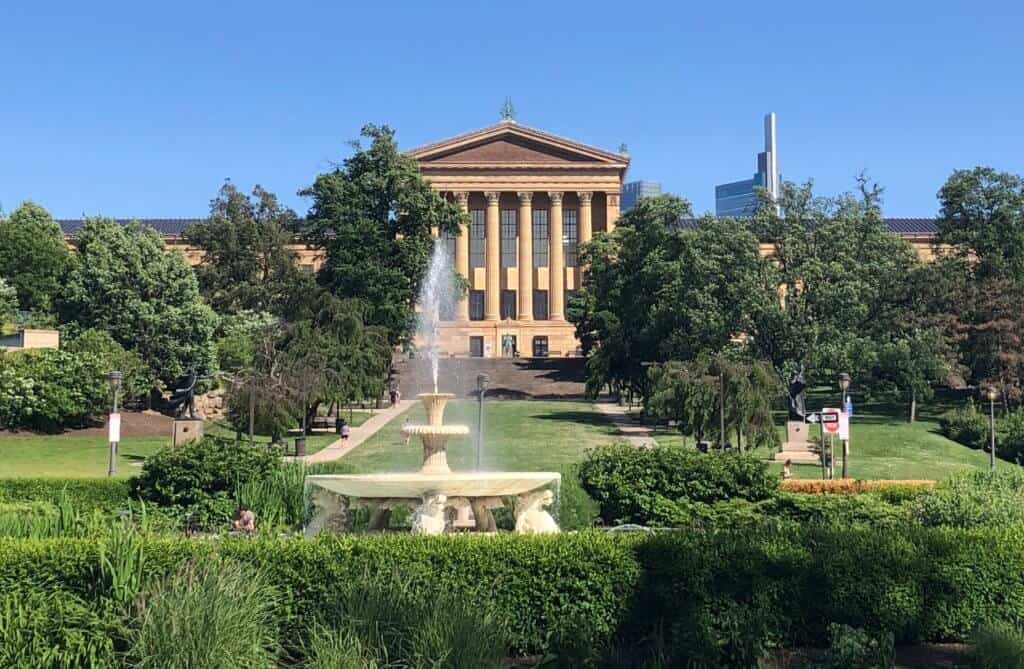
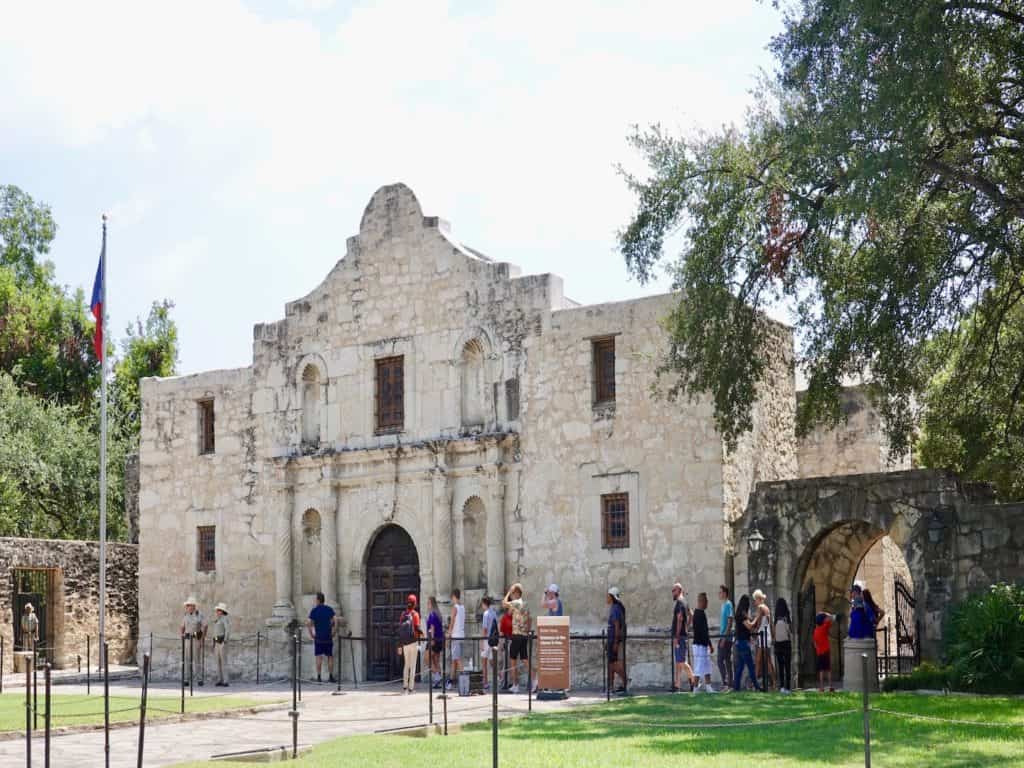
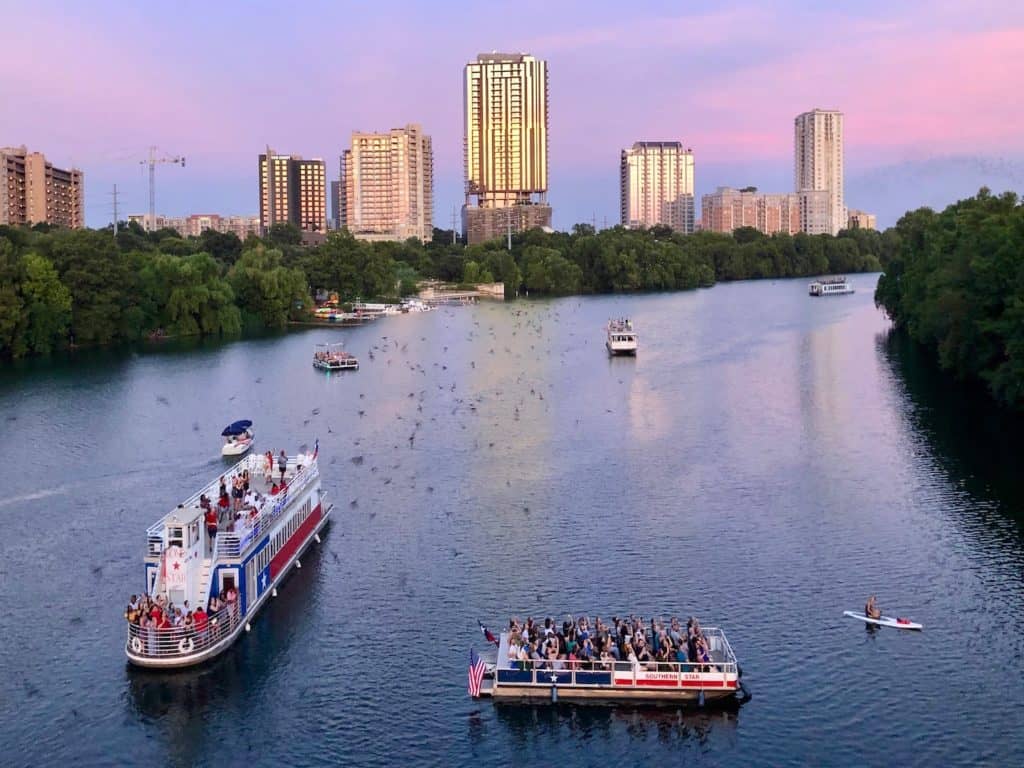
I’ve lived in Philadelphia for over a decade and I find some of the legends about City Hall fascinating. There was an unspoken agreement not to build a structure in Philadelphia surpassing the William Penn statue on top of the city hall tower. When One Liberty Place was completed in 1986, surpassing City Hall in height, it brought a “curse” on Philadelphia sports teams which was only lifted in 2008 when a small William Penn statuette was placed on top of the Comcast Center (then the tallest building in Philadelphia) and the Phillies went on to win the World Series that year.
Thanks for sharing that interesting bit of Philadelphia lore, Dean!
I grew up in PA, but learned so much from this post. I will have to go back to Philadelphia and do this walking route. Thank you for the thoughtful and thorough info.